Cuba

Cuba has always been in my mind. For some reason, the position in the Caribbean, its peculiar history, the fasciation of the name itself, I have always wanted to go there. And indeed it was as I expected it: stuck in the past but with aspiration for modernity in its citizens. I can't describe the joyful and yet surreal feeling of riding a car older than my parents but connected via bluetooth to my Spotify compilation. Only in Cuba these contradictions become possible. Cuba is different from whatever you may have seen before, Cuba is unique.
 In 2019, despite all the travels already planned for the same year, I decided to also go to Cuba to
spend
New Year’s Eve on the warm side of the planet.
In 2019, despite all the travels already planned for the same year, I decided to also go to Cuba to
spend
New Year’s Eve on the warm side of the planet.
I’ve always wanted to go to Cuba, there was something that attracted me and I am happy I decided
to go.
I
travelled with Viaggi e Avventure nel Mondo, the same company I travelled to Sri Lanka and
India
before. This time, also a colleague of mine joined, Mauro, and it was interesting to travel with a
friend in
a
group. You may think Cuba is small, but it is not so. Indeed, we had to skip some stops not to rush
all the
time. Still, we managed to cross the entire island!
To read this diary with the right atmosphere, I suggest you put on the entire album of Buena
Vista
Social Club. It seems a cliché, but the truth is those songs accompanied us along the entire
trip.
Day 1
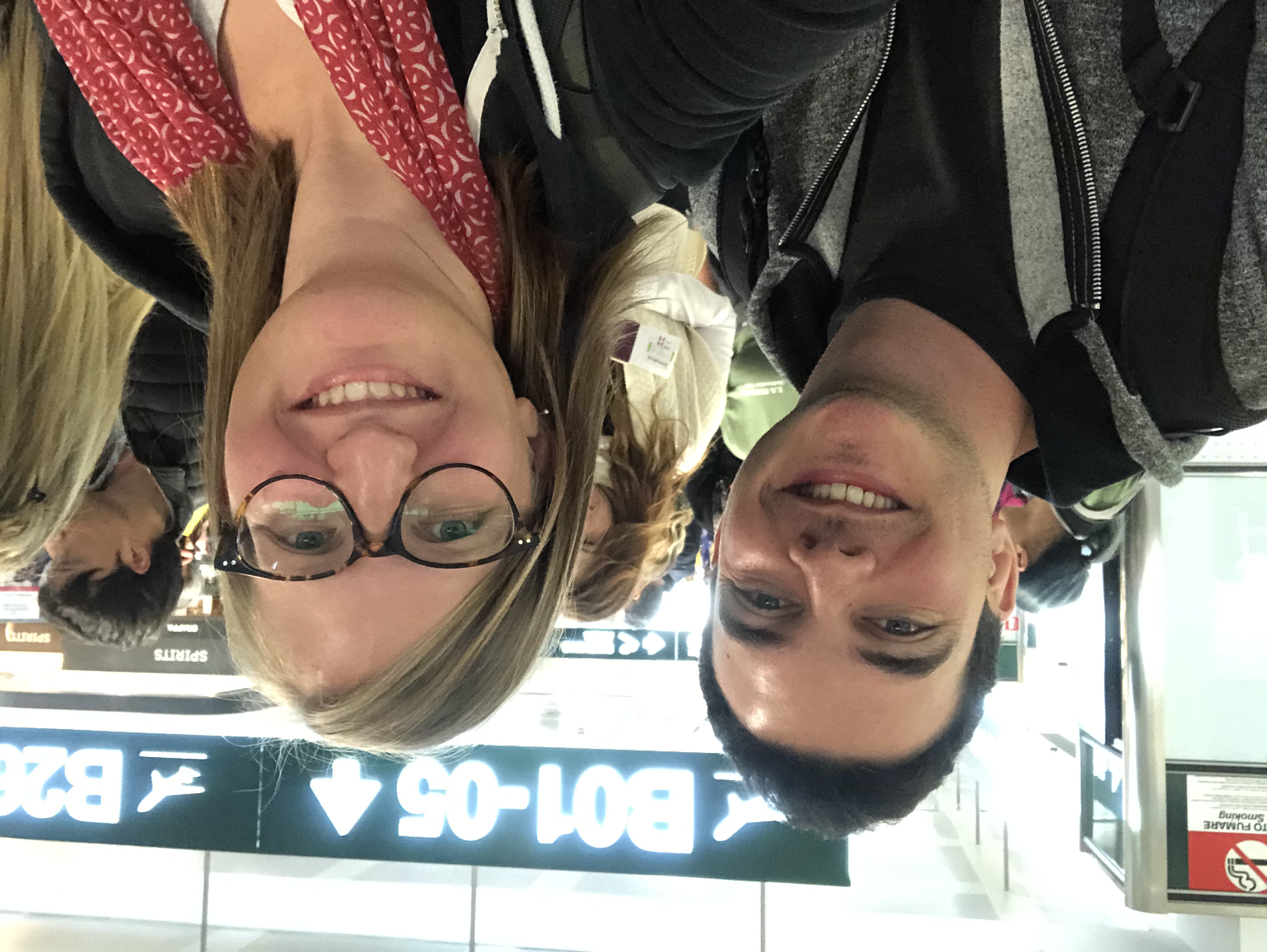 We left Milan on the 29th of December. We were supposed to leave on the 28th but there was no flight
availability, so we had to skip one day. The flight was so looooong and, even if I took the
anxiolytics my
dad
gave to me, they did not work that much (yeah, I do suffer a lot when flying). When we had some
turbulence,
I
started feeling bad. We flew with Blue Panorama, I think one of
the few companies allowed to go to Cuba but quite bad in terms of entertainment. There was no screen
and you
had a selection of maybe ten movies to watch on your device using the onboard
Wi-Fi. On the other side, the food was really good. We had lasagna and it tasted like real lasagna.
Maybe
not
the one you would get in a restaurant but still I guess you can’t have everything. We arrived in
Habana
around 11 PM and we spent more than an hour trying to exchange our money into CUC.
We left Milan on the 29th of December. We were supposed to leave on the 28th but there was no flight
availability, so we had to skip one day. The flight was so looooong and, even if I took the
anxiolytics my
dad
gave to me, they did not work that much (yeah, I do suffer a lot when flying). When we had some
turbulence,
I
started feeling bad. We flew with Blue Panorama, I think one of
the few companies allowed to go to Cuba but quite bad in terms of entertainment. There was no screen
and you
had a selection of maybe ten movies to watch on your device using the onboard
Wi-Fi. On the other side, the food was really good. We had lasagna and it tasted like real lasagna.
Maybe
not
the one you would get in a restaurant but still I guess you can’t have everything. We arrived in
Habana
around 11 PM and we spent more than an hour trying to exchange our money into CUC.
- Small note about money in Cuba. When I travelled there (now it has changed), there were two
currencies: the CUP and CUC. The first one is the peso cubano, also known as
moneda
nacional,
and it is the currency used by Cubans. Public salaries and pensions are paid in CUP. The second
one is the
peso cubano convertible, whose changing rate is the same as the American dollar. This is used by
tourists
and Cubans for hotels, petrol, restaurants and so on. Now, 1 CUC is worth about 25 CUP, meaning
that
whoever
doesn’t work with tourists has a small amount of money compared to the others. This led to a
huge gap
between Cubans as some can afford much more than others. –
There is a fascinating machine at the airport where, in an idyllic world, you put inside euros
and gets
CUC. I say idyllic because it took us many attempts and the help of a woman working there to
actually get
the
money changed. And not even all of us managed as 100 bills were not accepted and the machine liked
to make
disappear a bill here and there. Anyway, after a while, we were done. We went out and bought some
water
before
jumping on a taxi and head to the city centre. The fascinating thing about Cuba is that, as they
don’t have
internet (more on that later), they have an incredible memory for the street names. In about 40
minutes we
arrived at our casa particular (private house) and we divided into three rooms. We were so
tired that
we just had a quick shower and went to bed. In Europe, it was 5 in the morning.
Day 2
In the morning we had breakfast in the casa particular. It was average but gave us the strengths to
start
the
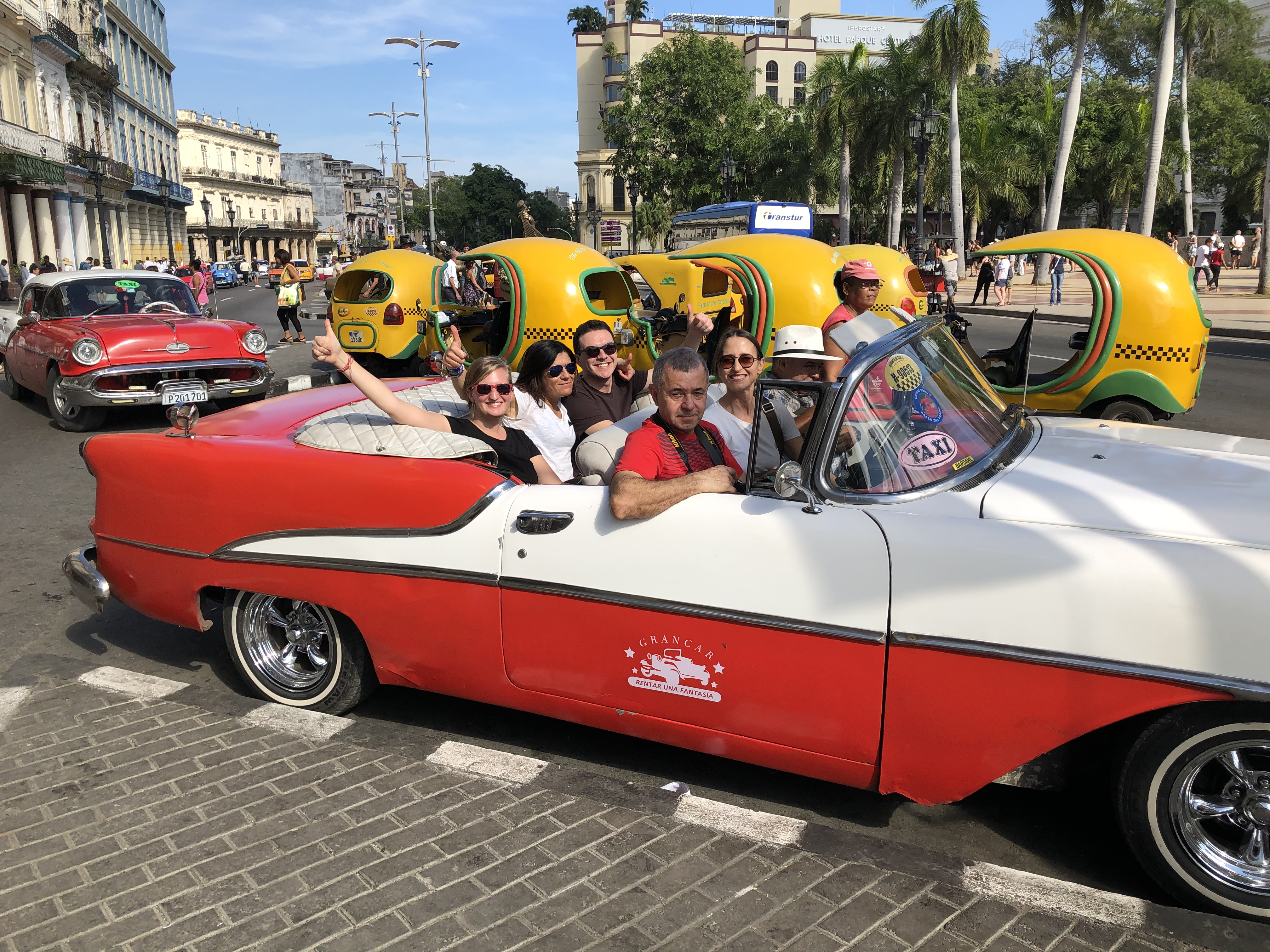 day. We discussed few things about the itinerary and then left to explore Habana. We were in
Habana
Vieja, so everything was nearby. We started going to see the Capitolio Nacional. It
is an
impressive building started in 1926 by the dictator Machado. At the time, sugar brought much money
to Cuba
and
17 million US dollars were spent to finish it. On the way there, we met first a
taxi driver that was very friendly and then a woman, Isabel, that started talking with us and told
us about
a
special deal to buy cigars. Since we all wanted to buy some, we followed her, and she took us
to a
house where they showed us the different brands. We then bought some at a good price and left.
day. We discussed few things about the itinerary and then left to explore Habana. We were in
Habana
Vieja, so everything was nearby. We started going to see the Capitolio Nacional. It
is an
impressive building started in 1926 by the dictator Machado. At the time, sugar brought much money
to Cuba
and
17 million US dollars were spent to finish it. On the way there, we met first a
taxi driver that was very friendly and then a woman, Isabel, that started talking with us and told
us about
a
special deal to buy cigars. Since we all wanted to buy some, we followed her, and she took us
to a
house where they showed us the different brands. We then bought some at a good price and left.
A bit further, we arrived at Parque Central and decided to take two cars to do a tour of
the
city.
Of course, the cars were American convertibles and we were excited. I took one with Mauro and
other
three people of the group. Since the time we moved, we realized our driver Rudy had some issues with
the
gear,
but we thought it was something related to the old car. We went to the Barrio Chino, where
there are
no
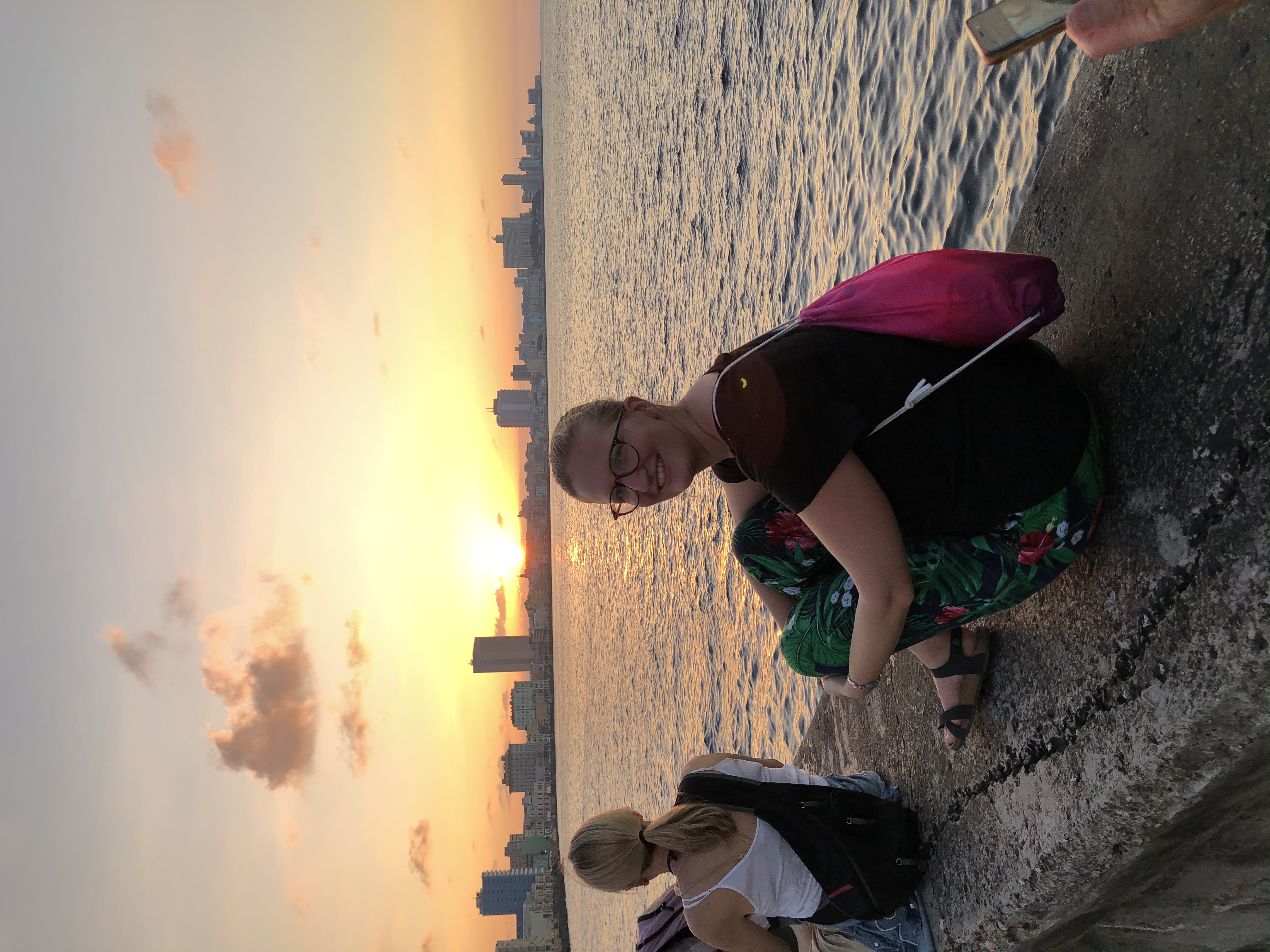 Chinese as they all left when the Revolution started, then went to Plaza de la Revolucion,
famous for
the big murals of Che Guevara and Camilo Cienfuegos. We then retook the car and, after
a bit,
the accident. As I mentioned, Rudy was not the best of the drivers, and, trying to stop, he
rear-ended
the car in front of us. Luckily, the crash was not too intense but still, we had to stop. Rudy was
really
afflicted because he said he had to pay back a lot of money and he just started driving cars to help
a
friend,
Lazzaro. In the meantime, we also asked him to call another car as we had to find the other half of
the
group
and finish the tour. After a good 40 minutes of waiting and our very first Tukola we bought
in a
nearby
bar, a car arrived to pick us up. We drove along the Malecón, a long road along the coast,
and then
went back into the city.
Chinese as they all left when the Revolution started, then went to Plaza de la Revolucion,
famous for
the big murals of Che Guevara and Camilo Cienfuegos. We then retook the car and, after
a bit,
the accident. As I mentioned, Rudy was not the best of the drivers, and, trying to stop, he
rear-ended
the car in front of us. Luckily, the crash was not too intense but still, we had to stop. Rudy was
really
afflicted because he said he had to pay back a lot of money and he just started driving cars to help
a
friend,
Lazzaro. In the meantime, we also asked him to call another car as we had to find the other half of
the
group
and finish the tour. After a good 40 minutes of waiting and our very first Tukola we bought
in a
nearby
bar, a car arrived to pick us up. We drove along the Malecón, a long road along the coast,
and then
went back into the city.
Unfortunately, we did not meet the others when the car stopped, and we started looking for them.
We had
not managed to find Cuban sim cards to buy and so we had to rely on SMS and common sense. It took
some hours
to finally reunite but we made it. We kept exploring Habana Vieja with the four squares, the
cathedral, and,
of course, the two iconic bars made famous by Hemingway: Floridita and Bodeguita del Medio.
These
bars
were full of tourists, so we were just ok with seeing them quickly, but we did not stop. By then, it
was
already starting to get dark, so we walked along the Malecón to go seeing the sunset. It was very
suggestive
also because a lot of people were there to enjoy the view. After that, we had our very first
mojito…that
tasted horrible, or better, it did not taste alcoholic. Anyway, it was nice to seat all together at
the end
of
the day and talk a bit. I was still trying to understand our travel mates. We were kind of tired
then and
went
back to the hotel. Just me and few others went for dinner.
Day 3
Here we are on the last day of 2019 and with still some adventure before finishing the year. Yes,
because we
had to go super early to the airport to get an internal flight to Baracoa, but the driver
took us to
the wrong terminal.
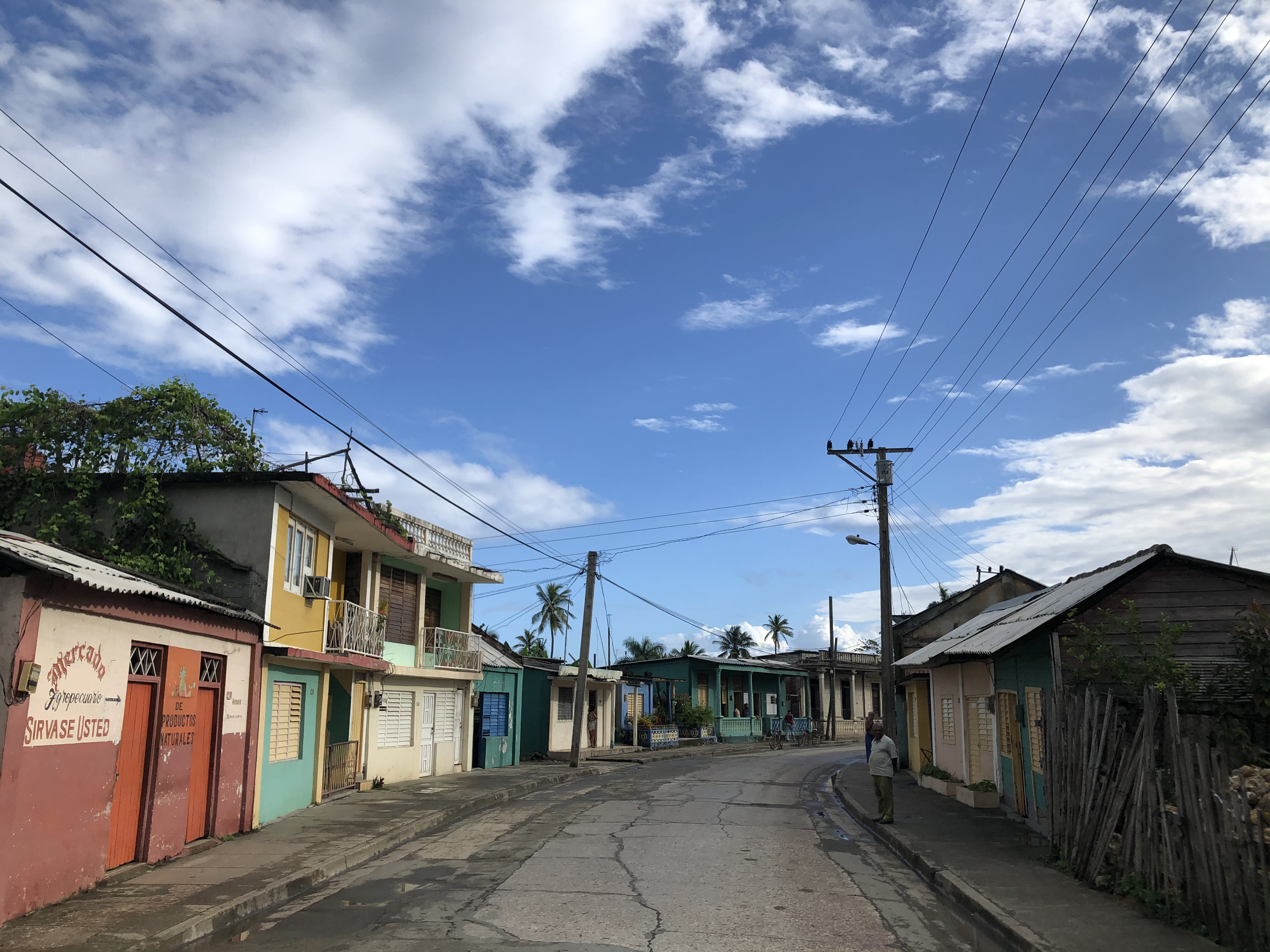 When we realized it, he was already gone and we discovered the terminal we had to go to
was super far, like half an hour walking in the middle of nowhere. We managed to find two taxis who
agreed
to
take us there even though in theory they were not allowed. We were 10 with the luggage and the taxi
could
take
4 people only but we puzzled us inside and here we were.
When we realized it, he was already gone and we discovered the terminal we had to go to
was super far, like half an hour walking in the middle of nowhere. We managed to find two taxis who
agreed
to
take us there even though in theory they were not allowed. We were 10 with the luggage and the taxi
could
take
4 people only but we puzzled us inside and here we were.
The airport was small, very small, and the people kept on telling us to line up for checking in
for
destinations like Cayo Coco or Cayo Santa María, popular destinations among tourists. They really
did not
understand why we wanted to go to Baracoa. Finally, we found the right line and checked in (quite
slowly,
each
boarding pass was hand-filled), and then headed to the gate. The waiting room (there was one gate
only)
looked
pretty much like a hospital one for the small it was. The bar was offering just a couple of things
and there
was nothing to do besides waiting.
About bars, shops, and restaurants, there is definitely something to say. Often they have
nothing
to
sell and when you ask for something like a soft drink or a local beer, you’re answered
they finished
it up. It is something we could never imagine. Yet there are inside people “working”. It left us
quite
shocked and never got used to it. There are also special shops in the cities where Cubans can go
buying
some
basics things such as rice, meat, coffee, soap with a discount through a government card. They
line up for
hours and still, what they get is not enough for survival.
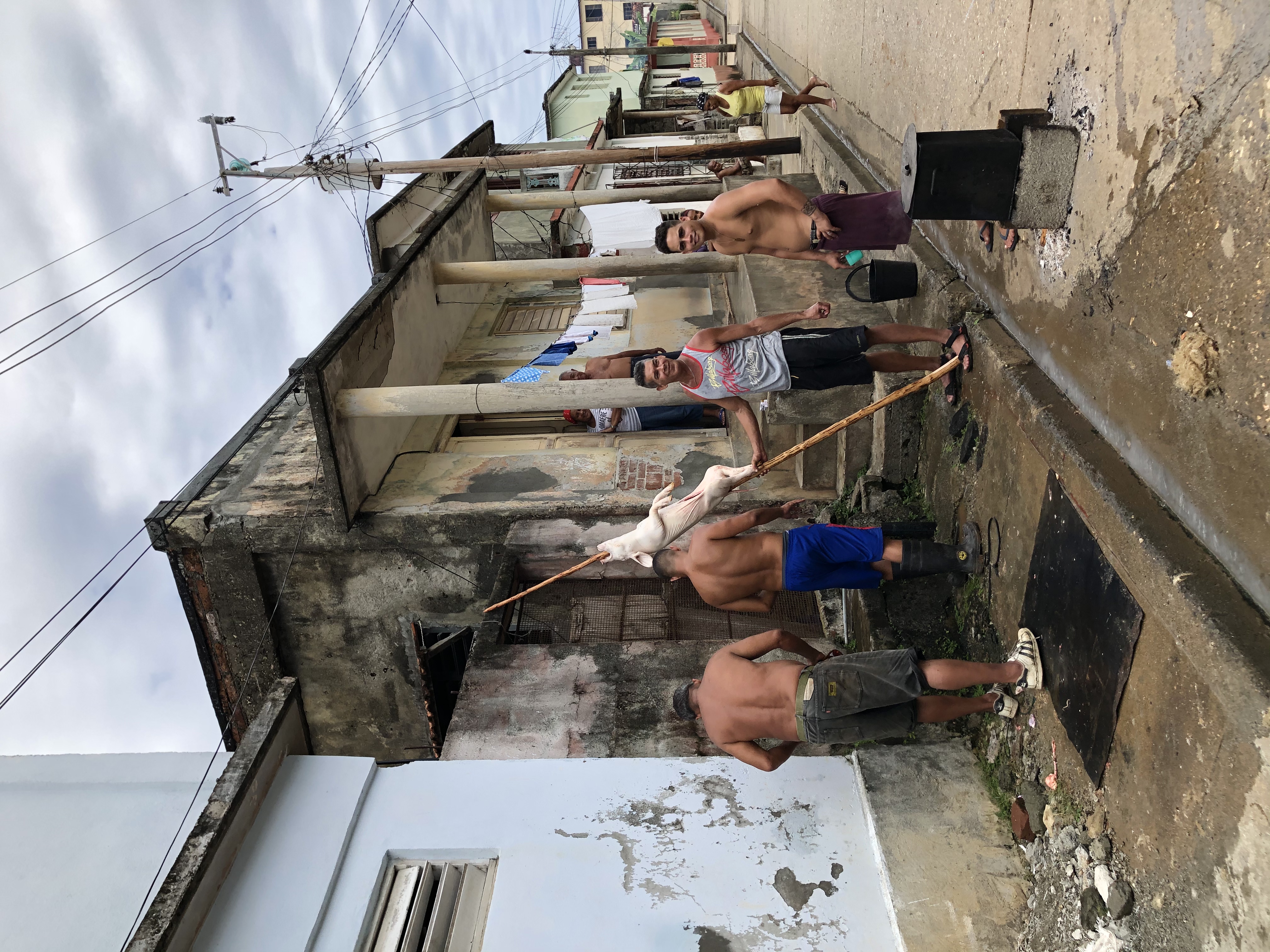
The flight was ok, I even fell asleep and there was no turbulence. We arrived in Baracoa after a
couple
of
hours and the atmosphere was completely different from the one in Habana. First, we were the only
tourists, the airport was super small, they were almost bringing us directly the luggage
from the
plane.
Outside, we found a van to take us all to the casa particular and, along the way, we fell in love
with the
city.
Once arrived at the casa, we had breakfast as it was probably 9 or 10 in the morning. Finally, I
had
something nice to drink. I don’t drink coffee, I really dislike it, but tea in Cuba is simply
disgusting.
However, Baracoa is famous for chocolate as it is the only city in the country using it in its
cuisine. So
hot
chocolate to begin the day!
Afterward, we went out to see a bit of the city. We soon realized that everyone was killing/cleaning
a
recently killed pig in the middle of the street. The reason was cerdo asado is the typical
meal for
New
Year’s Eve, so everyone was preparing dinner. For me that I love pig was a bit shocking at first
but, in the
end, they take care of their pigs with the idea of eating them one day but at least, while alive,
they are
free to move around, not like the animals we eat here, that never even see sunlight. Surely, seeing
some
intestines floating in the sea did not increase my appetite…
We saw the cathedral, the caves of the Tainos (one of the first populations of the
island) and
then
walked along the malecón.
In the afternoon, Leonardo (one of the group) said he wanted to see the hotel of La Rusa, so
I walked
there with him as some people went back to the casa particular and we split up. The hotel itself was
nothing,
just a small hotel. However, the guidebook said that La Rusa was a fascinating person and we were
curious to
know more. On the way back we found Valerio (another guy from the group) and we noticed there was a
small
sign
saying Museo La Rusa. It seemed to be a private house, so we just rang at the door and they
opened. A
few moments later, an old man arrived and led us to a room of the house where he stored a lot of
objects of
La
Rusa. And then, he told us his story. La Rusa was Magdalena Menasse Rovenskaya, an
aristocratic
Russian
whose family was killed by the Bolsheviks during the Russian Revolution in 1917. Only she and her
mother
managed to escape from Saint Petersburg to the Caucasus. At that time, she was only 6 years old. In
1924 she
arrived at Constantinople (Istanbul), where she met Albert Menasse, a Russian diplomat in Turkey,
with whom
she began a journey through Java, Italy, France, and finally Cuba, the land of her legend. To
survive, she
started performing as an opera singer in the main theatres of Europe like the Opera in Paris and La
Scala in
Milan. She arrived in Cuba in 1930 and from there she started managing some businesses in South
America
thanks
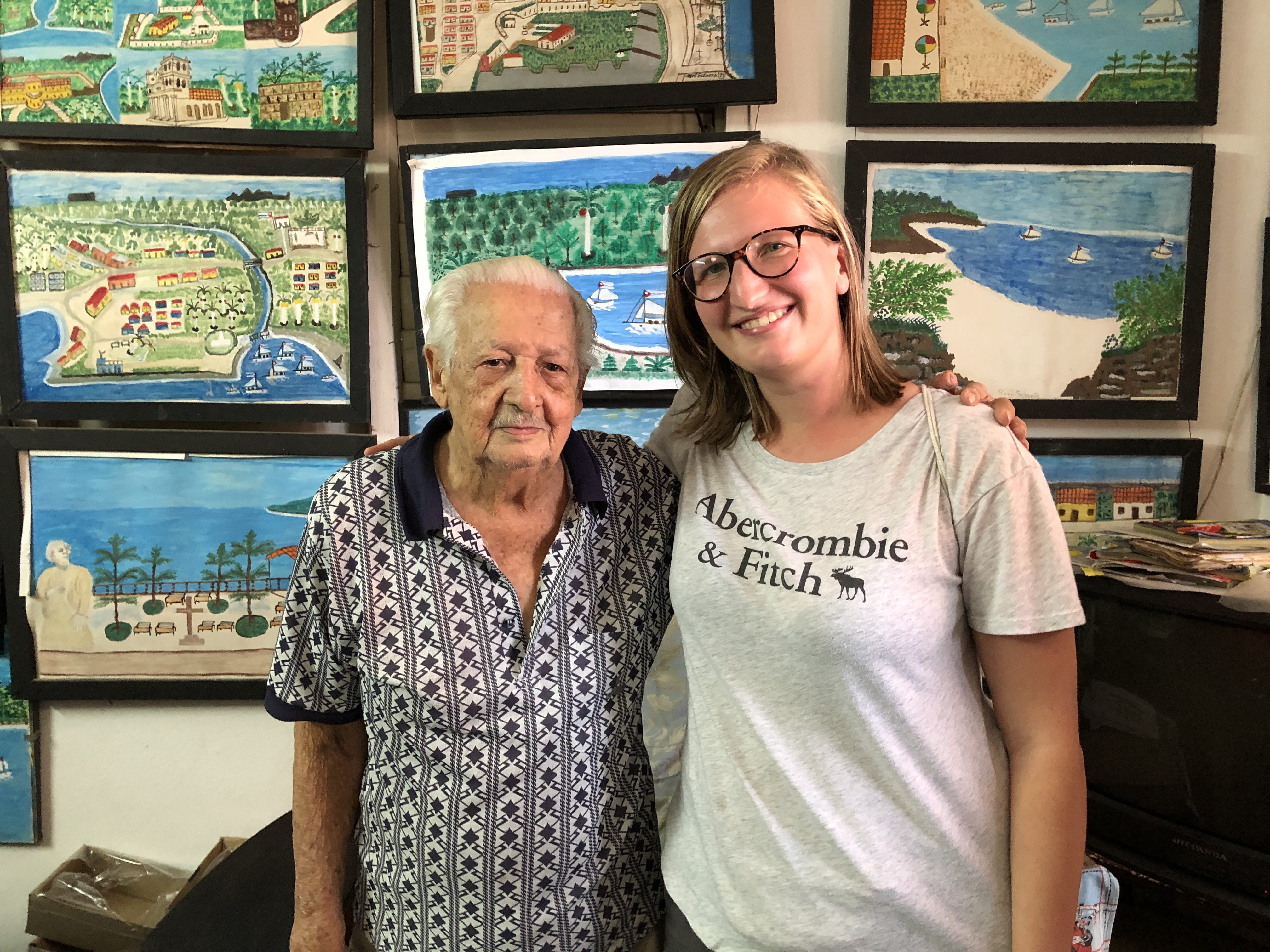 to the banana boom and the hotel that still exists. When the Revolution came to Cuba, she decided to
support
Fidel and his men providing money, food, and shelter and risking her own life. When Fidel eventually
took
the
power, she became an eminent figure in Baracoa. And then is where her story meets the one of José
René
Frometa, the old man who was telling us the story.
to the banana boom and the hotel that still exists. When the Revolution came to Cuba, she decided to
support
Fidel and his men providing money, food, and shelter and risking her own life. When Fidel eventually
took
the
power, she became an eminent figure in Baracoa. And then is where her story meets the one of José
René
Frometa, the old man who was telling us the story.
He was born in a poor family of Baracoa, being one among 27 children. He grew up with his
grandmother
that
always wanted him to study to improve his social status. Every day, going to the city to school, he
was
attracted by La Rusa and her friends that were always meeting in a bar. He was fascinated by the
strange
language they spoke, and, thanks to his curiosity, Albert finally noticed him. He offered him a
small job,
but
his grandmother forbade him to take it as he had to focus on his studies. He decided to do it anyway
in
secret. He had to bring the milk every day to their house and they would have paid him some money.
Later,
when
Jose was 8 years old, his grandmother died, and the Russian couple decided to adopt him officially
as they
grew affection for the child. However, his family had different plans and did not agree. They
believed the
spirit of his mom and grandmother would have suffered. In the end, they managed to take him, and he
could
finally join the family he, in fact, already had. It was moving to still see in his eyes the
expression when
he told us about the moment he entered the house as their son.
However, by the time he was saying all this and showing us clothes, objects, pictures of La Rusa,
the rest
of
the group started to go around looking for us. Thankfully, they passed by the house and we saw them
through
the window, so they also joined.
After that, we went to La Casa del Cacao, where we had a hot chocolate with some Ron.
By then, it was already about 5 PM so we headed back to the casa particular to shower and prepare
for
dinner.
The owner prepared one pork as well and we were all going to celebrate with other guests in the
terrace. The
evening was really nice, we had the traditional food, a lot of reguetón (at this point you can
temporarily
stop Buena Vista Social Club to listen to El Mentiroso by Gente de Zona , the song of the night),
some salsa
and a lot of mojitos. At midnight, after cheering, I went to the main square with Barbara, Mauro,
Costanza,
and Americo to dance and celebrating.
Day 4
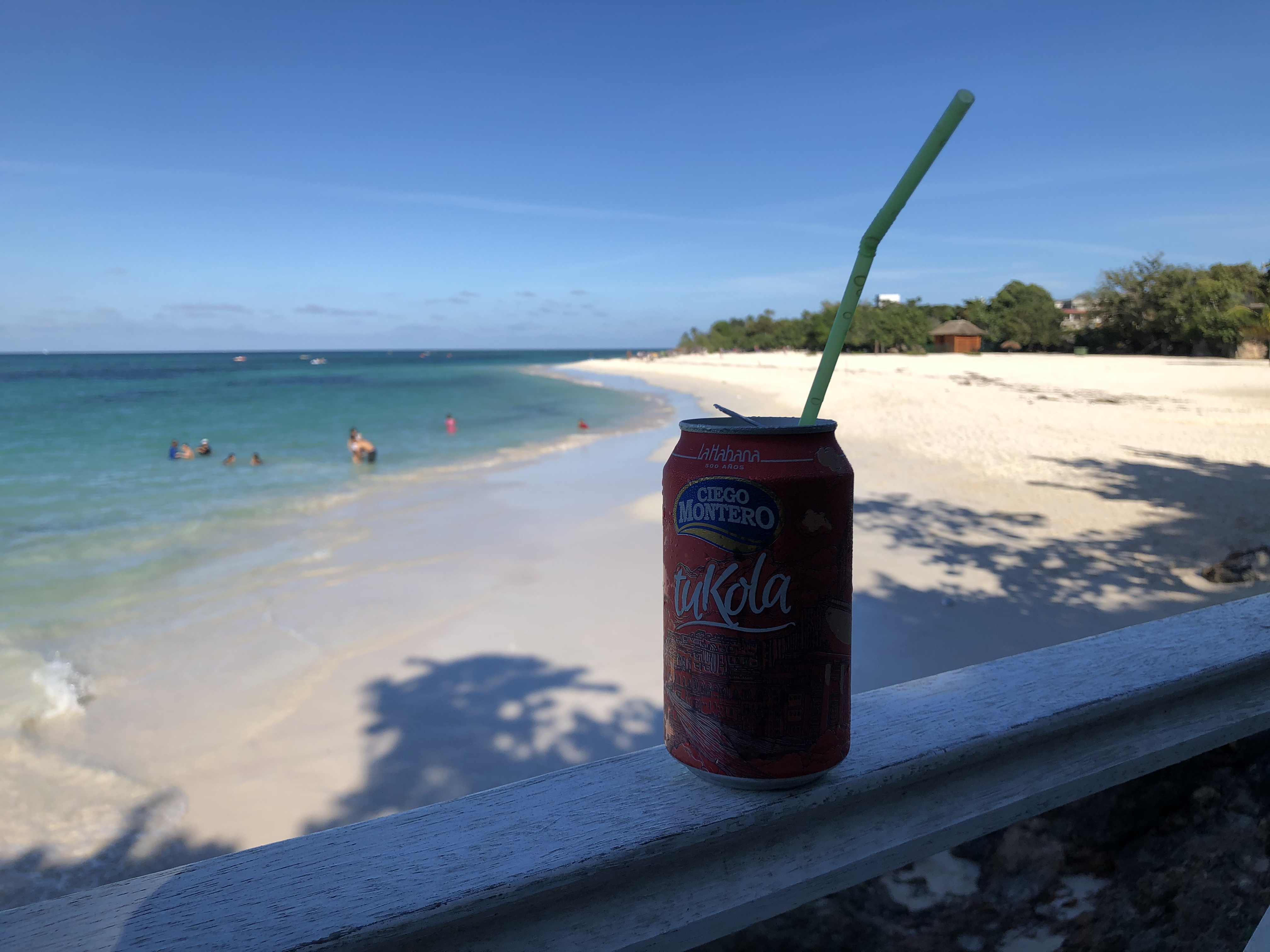 After a long day and night, here we are in 2020 (maybe it was not the best thing to celebrate, after
all...)!
We left in the morning as we had a long transfer ahead. On the itinerary, we were supposed to go to
Cayo
Saetia to the beach and then to Banes for the night but, once at the entrance of the
Cayo, we
discovered Raul Castro was there and so the access was forbidden. The transfer itself was nice,
though. We
were split into two cars and, how we soon discovered, that was the normality. Even if old, they were
quite
big
and therefore comfortable, but it was good just the fact that nowhere in the world you get to travel
like
this. Of course, they have their problems, but our unexpected stop was not too long.
After a long day and night, here we are in 2020 (maybe it was not the best thing to celebrate, after
all...)!
We left in the morning as we had a long transfer ahead. On the itinerary, we were supposed to go to
Cayo
Saetia to the beach and then to Banes for the night but, once at the entrance of the
Cayo, we
discovered Raul Castro was there and so the access was forbidden. The transfer itself was nice,
though. We
were split into two cars and, how we soon discovered, that was the normality. Even if old, they were
quite
big
and therefore comfortable, but it was good just the fact that nowhere in the world you get to travel
like
this. Of course, they have their problems, but our unexpected stop was not too long.
After finding the Cayo closed, we told the drivers to take us to another nice beach and so we
went to
Guardalavaca, north of Banes. The beach was amazing, the classic postcard you picture in your
head
when
you hear the word Caribbeans.
The sand was white, the beach wide, and the water light blue. It was wonderful! And thinking that in
Europe
it
was cold and grey made the experience even better. We stayed there the entire afternoon, got one
Tukola
(local
cola, almost better than the real one) and one Crystal (local beer, very light and good!) and
sunbathed.
What
can you desire more to kick off the year?
In the evening we went to Banes, where we were divided into three different casas particulares
and I
ended
up with Mauro. Our house was not bad, but I don’t mind anyway that much when traveling, especially
when I am
not in Europe. The casa where Barbara, Americo, Valerio, and Leonardo were was good, too.
Unfortunately, the
one where the other four people stayed was terrible: no sheets on the beds, no proper bathroom, and
half
room
under construction was the house. We had to stay two nights in that place as we wanted to include
some beach
and sun in the itinerary and this was the area that worked better. Unfortunately, everything else
was booked
so we had to stay in Banes. Also, the dinner was not the best. Let’s be honest, Banes was shit but
we were
there so… better adjust to it.
Day 5
Even in the morning, Banes was not exceptional, especially after breakfast with pineapple, bread,
butter,
and
hair of unknown origin. But it was fun, come on, and we also discovered there was a car parked in
the
kitchen,
or better, that the garage, the living room, and the kitchen were one unique space. Watch to
believe.
After a long wait as one of the drivers was almost two hours late, we all went to Playa
Esmeralda,
not far from the beach we were the day before. For the day, we had a beautiful Ford from the ‘50s
and an
American military jeep of the ’48. Unfortunately, in the rush of making amendments to the delay, the
driver
drove so fast that he did not see a dog suddenly crossing the street and he killed him. This put us
in a bad
mood but there was nothing we could do.
Playa Esmeralda was beautiful as well, with the water really looking like an emerald. We spent there
an
entire
day before driving to a restaurant in the area and then driving back to Banes.
Day 6
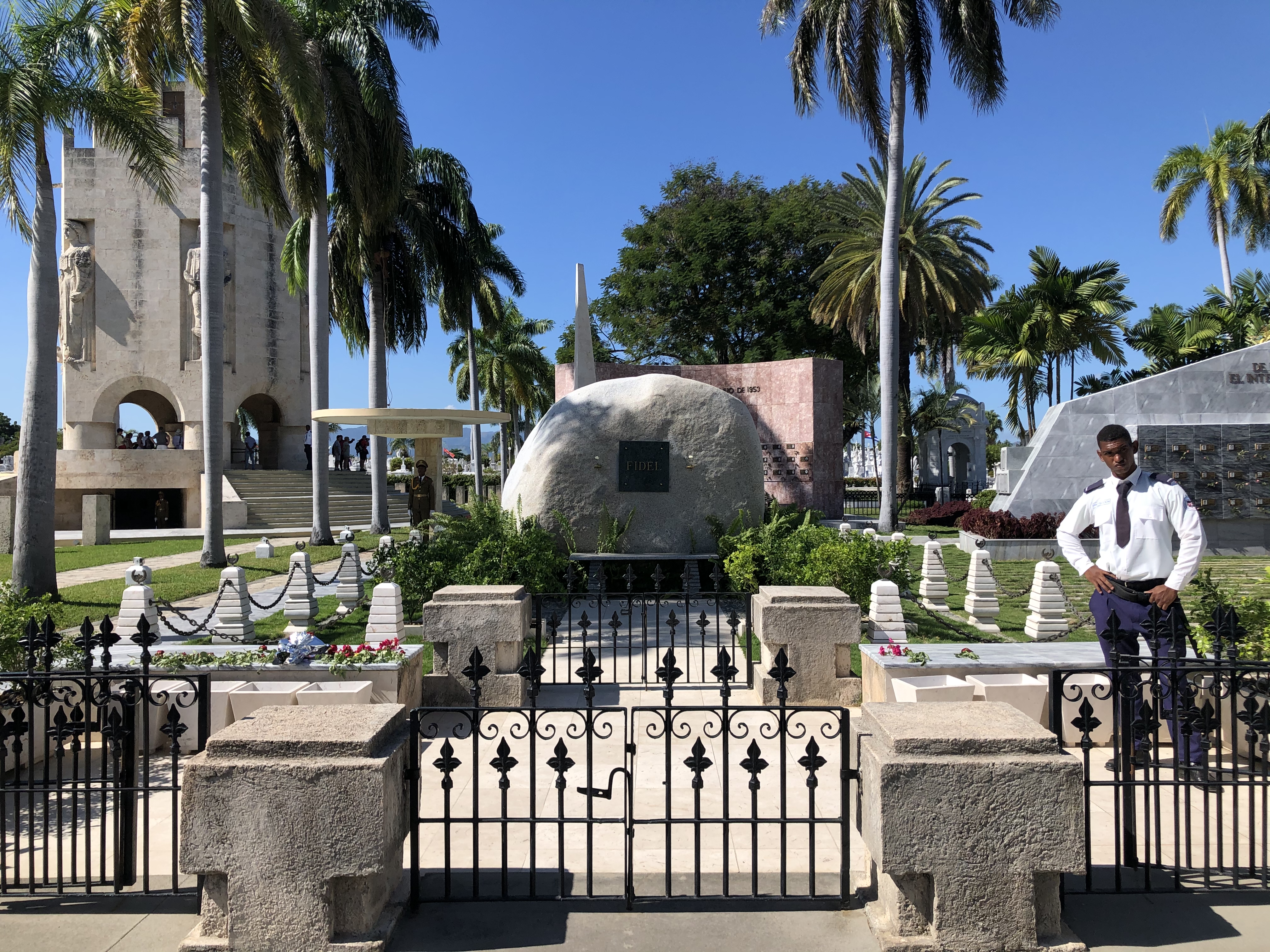 We left the beaches heading south to Santiago, one of the best cities we have been to. The
travel was
about three hours long and we also had the pleasure to see president Miguel Díaz Canel (well, his
car, to be
precise) and all the cars around him passing by super-fast. The two drivers we had, again to
apologize for
the
delay of the previous day, decided to take us to the Cementerio Santa Ifigenia, just outside
of the
city of Santiago, to save us some time. Of course, this is one of the compulsory stops in Cuba. The
main
protagonist is Jose Marti, whose mausoleum is quite big and visible from the entrance. Since
2016,
another celebrity arrived here: Fidel Castro. Not to become an icon as Che, he forbade the
use of his
images for any propagandistic activity and wanted to be buried in a stone. No huge tombs and statues
for
him.
For the joy of visitors, at fixed times there is the ceremony of the changing of guards as Marti’s
mausoleum
is always guarded by three soldiers. Besides them, there are also other personalities resting in
this
cemetery: Compay Segundo (you listened to Chan Chan, right? That’s my favorite from the
album),
Emilio Bacardi, and many others.
We left the beaches heading south to Santiago, one of the best cities we have been to. The
travel was
about three hours long and we also had the pleasure to see president Miguel Díaz Canel (well, his
car, to be
precise) and all the cars around him passing by super-fast. The two drivers we had, again to
apologize for
the
delay of the previous day, decided to take us to the Cementerio Santa Ifigenia, just outside
of the
city of Santiago, to save us some time. Of course, this is one of the compulsory stops in Cuba. The
main
protagonist is Jose Marti, whose mausoleum is quite big and visible from the entrance. Since
2016,
another celebrity arrived here: Fidel Castro. Not to become an icon as Che, he forbade the
use of his
images for any propagandistic activity and wanted to be buried in a stone. No huge tombs and statues
for
him.
For the joy of visitors, at fixed times there is the ceremony of the changing of guards as Marti’s
mausoleum
is always guarded by three soldiers. Besides them, there are also other personalities resting in
this
cemetery: Compay Segundo (you listened to Chan Chan, right? That’s my favorite from the
album),
Emilio Bacardi, and many others.
- In every place you go in Cuba, you won’t see any Castro or Guevara street/square/station
and so on.
On the other side, you will be bombed with Marti’s name everywhere and see many busts. The
reason is Jose
Marti is considered the undisputed father of the nation. From a young age, he promoted
the idea of
liberty and went on being a poet, philosopher, and professor, a sort of free thinker. At the
time, Cuba
was
a Spanish colony, and spreading ideas about independence was dangerous. Because of it, Marti had
to spend
many years abroad and came back only in 1894, the year in which he died in the battle of Dos
Rios.
Probably
also because of his heroic death, he is still considered the most relevant figure in Cuba. -
After this dive into Cuban history, we went to our casa particular. This time we divided into
two
houses,
one in front of the other. Mauro and Valerio went to one while the rest of us to the other. We had a
small
briefing to exchange reflections before going out and exploring the city. The day Santiago was very
nice and
we walked a lot. Being the city on a hill, we ended up exhausted. On our wandering, we also stopped
at the
Museo de la Lucha Clandestina, a museum detailing the underground struggle against Batista in
the
1950s. The museum was a former police station attacked by M-26-76 activists (26th of July
Movement,
was
a Cuban revolutionary organization and later a political party led by Fidel Castro) on November 30,
1956, to
divert attention from the arrival of the tardy yacht Granma, carrying Fidel Castro and 81 others.
The museum
was really interesting, with a lot of pictures and documents of those years. Then, we kept on going
in our
walking and we arrived in the main square. As I stopped to buy some postcards, an old woman
approached me
and
started talking.
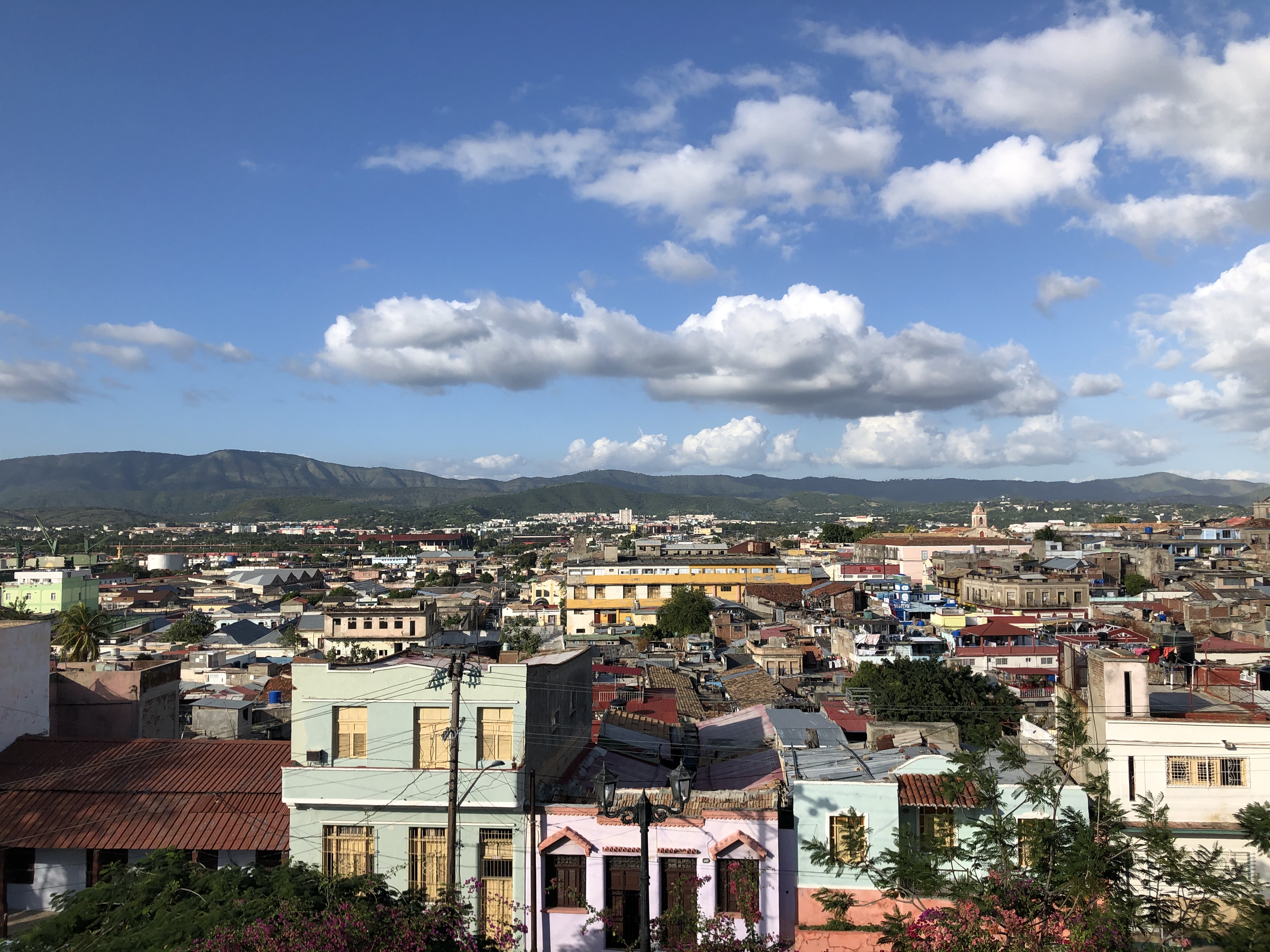
I discovered her name was Isabel and she was 70ish years old. She really seemed to want to talk
about
her
story, so she told us about the times she was young, and Cuba was ruled by Batista. As Santiago was
the city
from where the Revolution started (the Castro family was originally from the area), the people
really had
bad
times when the army arrived. In the attempt to stop any support to the fighters hidden in the
mountains,
they
killed many innocent civilians, often poor farmers. Her family was secretly aiding the fighters and
she
risked
her life more than once, due to soldiers sent to search the houses and the bombs. She also told us
that she
saw Fidel twice, the first time on the 1st of January 1959, the day he took power and had his first
speech
in
Santiago, and then later in Habana. Later on, I went with Barbara (our amazing coordinator and
friend) to a
bar to have our first pina colada in Cuba. It was strong because my head started spinning
soon but at
least we relaxed for a while. For dinner, we went back to the house, where the owner (Mabel)
prepared
lobster.
It had a strange taste, but I liked it.
After dinner, we went out and I ended up with Barbara, Mauro, and Valerio at La Casa de la
Trova,
a
bar where there is live music every evening. I also managed to dance a bit of salsa, finally!
However, I
must
confess I thought I would have had more chances to dance but it seems Cubans really dance only among
themselves at private parties. We had a great time and we came back at 2. The sleep time was getting
reduced
more and more every day!
Day 7
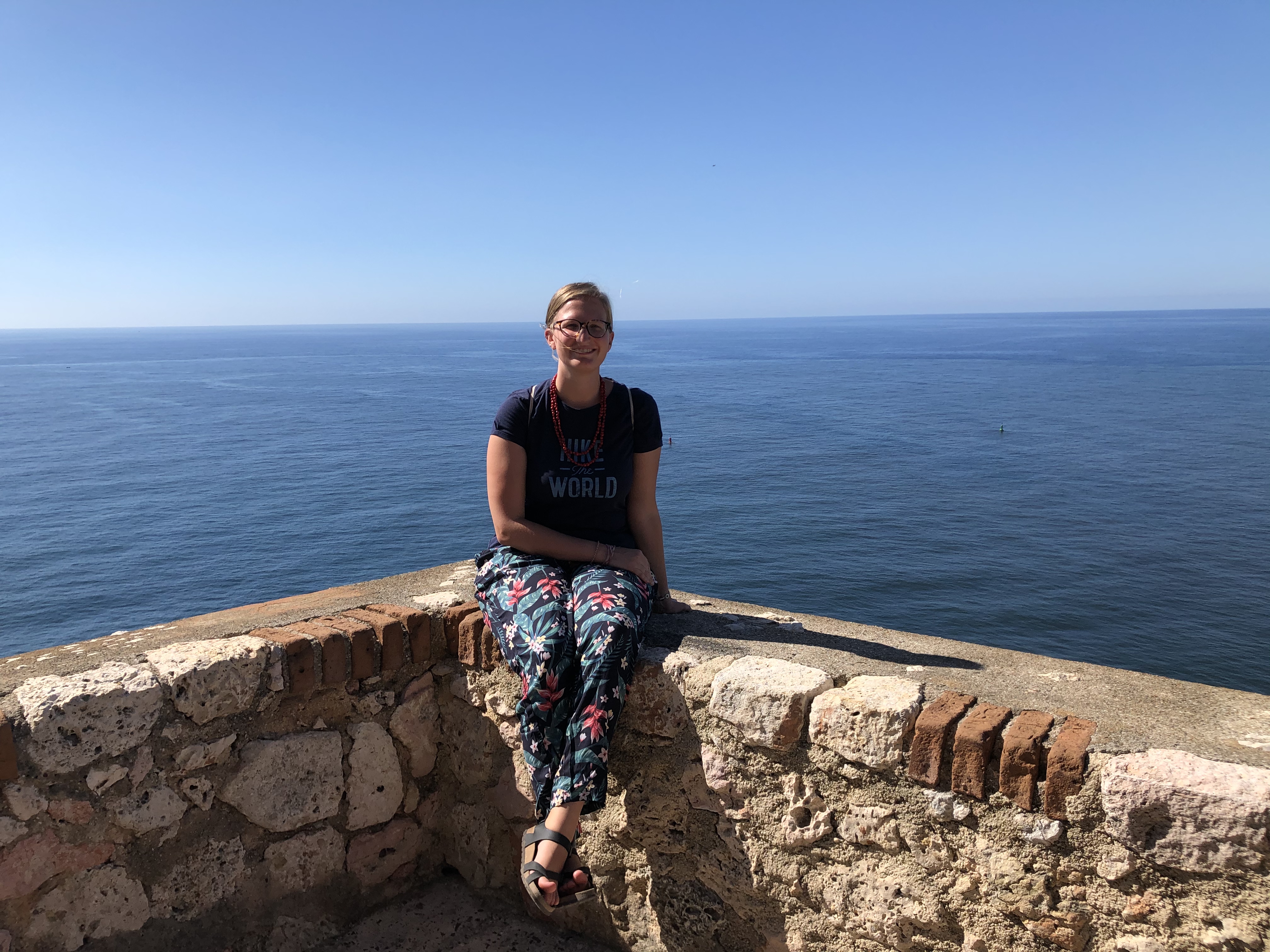 The morning after, Barbara was not feeling well so she stayed back while we all decided to go to
visit el
Castillo de San Pedro de la Roca. It took us a bit to contract a car and a sort of open van
to take
us
there, but we managed. This fortress is at the entrance of the bay where the city of Santiago is
built,
about
10 km out of the city so it took us some time to arrive, but it was totally worth it. It is one of
the
best-preserved fortresses in the Caribbean and, since 1997, also a Unesco site. There was a guy
explaining
to
us the story of the monument and we discovered that it was projected by an Italian architect,
Giovan
Battista Antonelli, to defend the city from pirates’ attacks in 1637. It took 42 years to complete,
during
which there were indeed attacks led by English pirates. For this reason, the original plan was later
modified
in order to fortify the coast even more. Nowadays, the built is made up of different parts of
different ages
due also to the different use of the building. Starting in 1775, the fear of pirates was not so high
anymore,
so the fortress became a prison for political prisoners, and it was eventually used for the last
time in
1898
when the United States fleet attacked the island during the Spanish-American War.
The morning after, Barbara was not feeling well so she stayed back while we all decided to go to
visit el
Castillo de San Pedro de la Roca. It took us a bit to contract a car and a sort of open van
to take
us
there, but we managed. This fortress is at the entrance of the bay where the city of Santiago is
built,
about
10 km out of the city so it took us some time to arrive, but it was totally worth it. It is one of
the
best-preserved fortresses in the Caribbean and, since 1997, also a Unesco site. There was a guy
explaining
to
us the story of the monument and we discovered that it was projected by an Italian architect,
Giovan
Battista Antonelli, to defend the city from pirates’ attacks in 1637. It took 42 years to complete,
during
which there were indeed attacks led by English pirates. For this reason, the original plan was later
modified
in order to fortify the coast even more. Nowadays, the built is made up of different parts of
different ages
due also to the different use of the building. Starting in 1775, the fear of pirates was not so high
anymore,
so the fortress became a prison for political prisoners, and it was eventually used for the last
time in
1898
when the United States fleet attacked the island during the Spanish-American War.
Once back to Santiago, we arranged with the owner of the casa the next car transfer and housing.
Everything was really organized day by day thanks to the contacts of the houses and the drivers.
That same
evening we were taking the night bus to Santa Clara, but we still had no car waiting
for us
there and no place to sleep in Trinidad, our next destination. Fixed that, we divided into two
groups. I
went
with Barbara to the bus station to check the bus status for the night. It is not uncommon that buses
are
delayed and/or canceled. We took a tuk-tuk to go there, so fun! The rest of the group walked to el
Cuartel
Moncada,
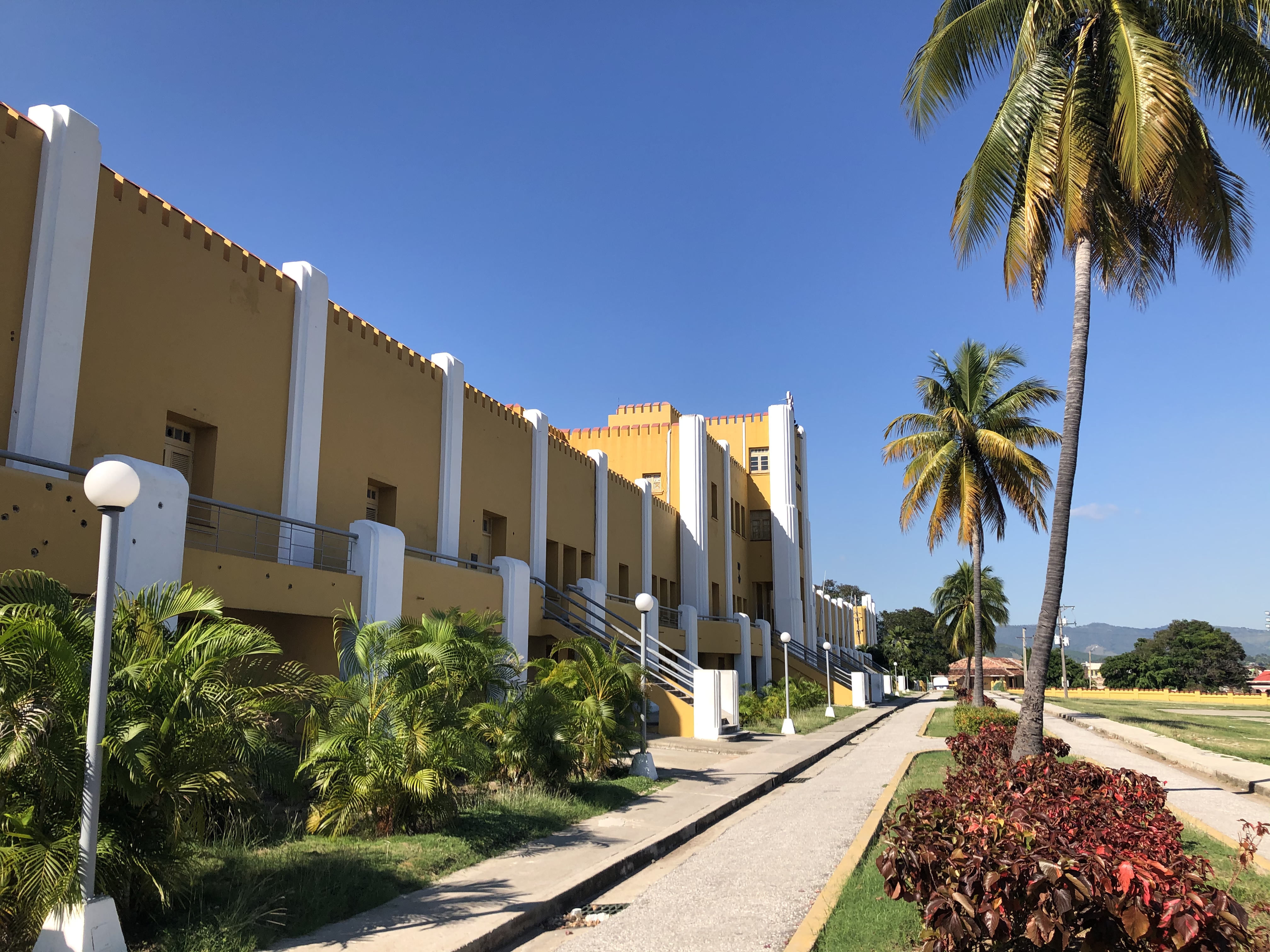 probably one of the most iconic places of the Revolution and the most famous of Santiago. We
arrived shortly after them and went inside together to visit it. The yellow building nowadays
transformed
into
a school and little museum was the second-largest military garrison of the island. On the 26th of
July 1953,
Fidel led a group of about 135 men, including his brother Raul to an attack with the idea of taking
over the
control of the building and possession of the weapons. The men were divided into different groups,
all
dressed
up like soldiers. The first men arriving at the barracks killed the guards but some of them escaped
and gave
the alarm. Fidel’s men were then killed on the ground or taken as prisoners. Later, almost all of
them were
tortured and killed inside the very same building. Only Fidel and few others managed to escape to
the Sierra
Maestra and were found days later. Thanks to this delay, they saved their life and Fidel had a
proper trial
during which he gave a speech, a copy of which was smuggled outside and was then published with the
title
History will absolve me. Written to defend himself, the speech is indeed an accusation of
Batista’s
government crimes. The museum is interesting to follow the events that led to the attack and what
happened
before. There are some memorabilia and many pictures and panels. Since the guided visit was free, we
also
had
a woman walking us through everything but it was indeed a must-do in the city.
probably one of the most iconic places of the Revolution and the most famous of Santiago. We
arrived shortly after them and went inside together to visit it. The yellow building nowadays
transformed
into
a school and little museum was the second-largest military garrison of the island. On the 26th of
July 1953,
Fidel led a group of about 135 men, including his brother Raul to an attack with the idea of taking
over the
control of the building and possession of the weapons. The men were divided into different groups,
all
dressed
up like soldiers. The first men arriving at the barracks killed the guards but some of them escaped
and gave
the alarm. Fidel’s men were then killed on the ground or taken as prisoners. Later, almost all of
them were
tortured and killed inside the very same building. Only Fidel and few others managed to escape to
the Sierra
Maestra and were found days later. Thanks to this delay, they saved their life and Fidel had a
proper trial
during which he gave a speech, a copy of which was smuggled outside and was then published with the
title
History will absolve me. Written to defend himself, the speech is indeed an accusation of
Batista’s
government crimes. The museum is interesting to follow the events that led to the attack and what
happened
before. There are some memorabilia and many pictures and panels. Since the guided visit was free, we
also
had
a woman walking us through everything but it was indeed a must-do in the city.
Afterward, we went for a drink and I had my first daiquiri, another cocktail invented in
Cuba. In
the end, it is just a mojito with no mint, nothing special. After restoring, we went back to the
casa,
showered, and had dinner before going to the bus station. Everything had to be simple: we just had
to go to
the ticket counter of Viazul, the bus company, and get the actual tickets after showing our
reservation. But we don’t like easy things and, once our turn arrived, the woman said to me and
Barbara (the
others were looking after the luggage) we only had 8 tickets instead of 10. Of course. It took us
more than
half an hour (thankfully we were early) to have 10 tickets. She insisted on the computer she had
only that,
that at the moment of the reservation something went wrong and she could not help us as the bus was
full.
Barbara told me not to move unless we had all the tickets we were entitled to and kept on insisting.
The
woman also threatened us to call the police (maybe it would have helped!) and then, suddenly, she
said she
could check by the names instead of by reservation number and, voilà, the 2 missing people magically
appeared on her screen. You may think everything was fine then but no, she had to give us the proper
tickets
and, again, of course, she had to fill them all by hand! In the meantime, the line behind us grew
super long
even though no one was complaining, and we started breathing again after risking few heart attacks.
Even
after all this, the story was not finished as the bus was delayed for some mechanical problem. We
had to
wait a couple of extra hours but then, we made it!
Day 8
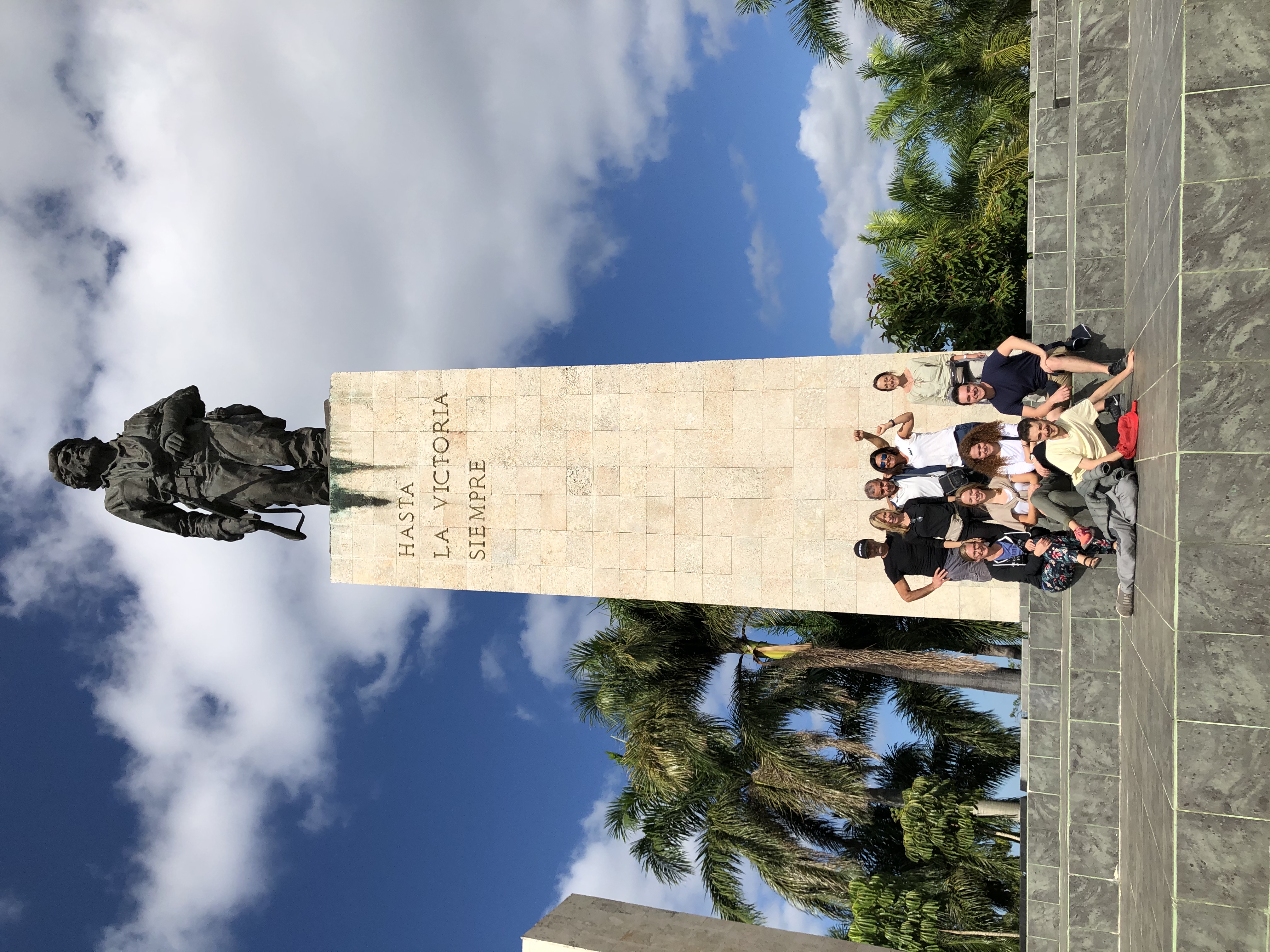 The bus ride was long, more than 12 hours, and extremely cold even though we prepared warm clothes
in
advance. We stopped for breakfast around 7 and had one of the most memorable ones with coffee,
sandwich, and
ice cream. Then, we continued our ride until Santa Clara, where we arrived with more than 4 hours of
delay.
Thankfully, we already had a car to pick us up otherwise we would have lost other precious time
looking for
one. The car, if it can be called so, was enough big to bring us all together but I still wonder how
could
work. Besides being old, like every other car in Cuba, it was literally falling apart. Also, the
noises it
made all the time were not heartening.
The bus ride was long, more than 12 hours, and extremely cold even though we prepared warm clothes
in
advance. We stopped for breakfast around 7 and had one of the most memorable ones with coffee,
sandwich, and
ice cream. Then, we continued our ride until Santa Clara, where we arrived with more than 4 hours of
delay.
Thankfully, we already had a car to pick us up otherwise we would have lost other precious time
looking for
one. The car, if it can be called so, was enough big to bring us all together but I still wonder how
could
work. Besides being old, like every other car in Cuba, it was literally falling apart. Also, the
noises it
made all the time were not heartening.
Santa Clara is a small city famous for being the place where the Revolution took place and for
the
connections with Che Guevara. The first place we visited was indeed the Che Mausoleum.
In
1997, after his tomb was discovered in Bolivia, his spoils and the ones of 29 fellow fighters were
moved
here. The mausoleum is a very peaceful place, where a sort of jungle has been recreated. Next to it,
there
is a museum with many objects, letters, and pictures of Che, depicting his life in Argentina and
then his
battles in Cuba and beyond. Outside, there is a huge statue of Che with the iconic sentence:
Hasta la
Victoria, Siempre.
After that, we went to visit the museum of the train that, unfortunately, was closed. However, it
was still
possible to see the monument with the remains of the armored train that, in December 1958, was
captured by
the men of Che. This event, even if not as big as you could think, led to the escape of Batista from
the
island and to the ultimate victory of the revolutionaries. With no guide, the army surrendered, and
Fidel
finally took power.
As we were already late on the program, we decided to then skip the visit to the city of
Remedios and
drive directly to Trinidad. It was a long transfer, especially with that car, but still
scenic as we
drove along the coast. Arrived in Trinidad, we split between two casas particulares as the one we
booked did
not have space for all of us. All the women were in one and the men on the other side of the street.
We just
had time to shower and then we went out for dinner.
Dinners were one of the most difficult moments of the day because already tired and exhausted, we
had to
battle with one part of the group wanting to eat “fancy” while the others wanting something more
authentic
and spartan. In any case, why would you go to Cuba if you want to eat well? Cuban cuisine is indeed
awful
and there is no variety, probably the fact they had no food for a long time did not help… That night
we
ended up in a restaurant that, even though the food was good, looked terrible. As we asked to
explain what
some dishes were, the waiter switched the TV (huge screen, better than the one I have at home!) on
and
showed us a video with the food pictures. I was shocked and the entire situation was paradoxical.
After
dinner, we walked around the town and listened to some live music while drinking some mojitos.
Day 9
 After a restoring night and a huge breakfast (breakfasts are quite good in the casas as they usually
give
you coffee, juice of some fruit, bread, butter, jams, cold cuts of mysterious origin, and fruit), we
left to
go exploring the city of Trinidad. It is a beautiful city even if very touristic. It was strange to
see so
many tourist shops. Shops, in general, are not common in Cuba and, if there are, most probably they
will be
empty while these were exploding with any sort of souvenir. Among the usual stuff you would find as
a
souvenir in any country, I bought something original. Out of cans, they made “cameras” which, when
clicking
would open and a spring would jump outside. Ok, the description is weird and probably does not give
an idea
but my Tukola camera is amazing. We made a tour of the city that was interesting, even if the
city is
very small. We also went to the top of Palacio Cantero, where there is the Museum of the
Municipality
History. The view from there was beautiful but the palace inside was interesting, too, as it
contains old
furniture and pictures of various periods of Trinidad. Another interesting moment was when we found
the
house of the Santeria, one of the religions practiced in Cuba. Mauro was (still is) terrified
by the
black dolls they keep inside… The priest inside, when we ask to explain something about the
religion,
started saying a lot of bulls**t and we were nodding just in the hope he would have stopped soon but
he had
to say a lot of things, apparently.
After a restoring night and a huge breakfast (breakfasts are quite good in the casas as they usually
give
you coffee, juice of some fruit, bread, butter, jams, cold cuts of mysterious origin, and fruit), we
left to
go exploring the city of Trinidad. It is a beautiful city even if very touristic. It was strange to
see so
many tourist shops. Shops, in general, are not common in Cuba and, if there are, most probably they
will be
empty while these were exploding with any sort of souvenir. Among the usual stuff you would find as
a
souvenir in any country, I bought something original. Out of cans, they made “cameras” which, when
clicking
would open and a spring would jump outside. Ok, the description is weird and probably does not give
an idea
but my Tukola camera is amazing. We made a tour of the city that was interesting, even if the
city is
very small. We also went to the top of Palacio Cantero, where there is the Museum of the
Municipality
History. The view from there was beautiful but the palace inside was interesting, too, as it
contains old
furniture and pictures of various periods of Trinidad. Another interesting moment was when we found
the
house of the Santeria, one of the religions practiced in Cuba. Mauro was (still is) terrified
by the
black dolls they keep inside… The priest inside, when we ask to explain something about the
religion,
started saying a lot of bulls**t and we were nodding just in the hope he would have stopped soon but
he had
to say a lot of things, apparently.
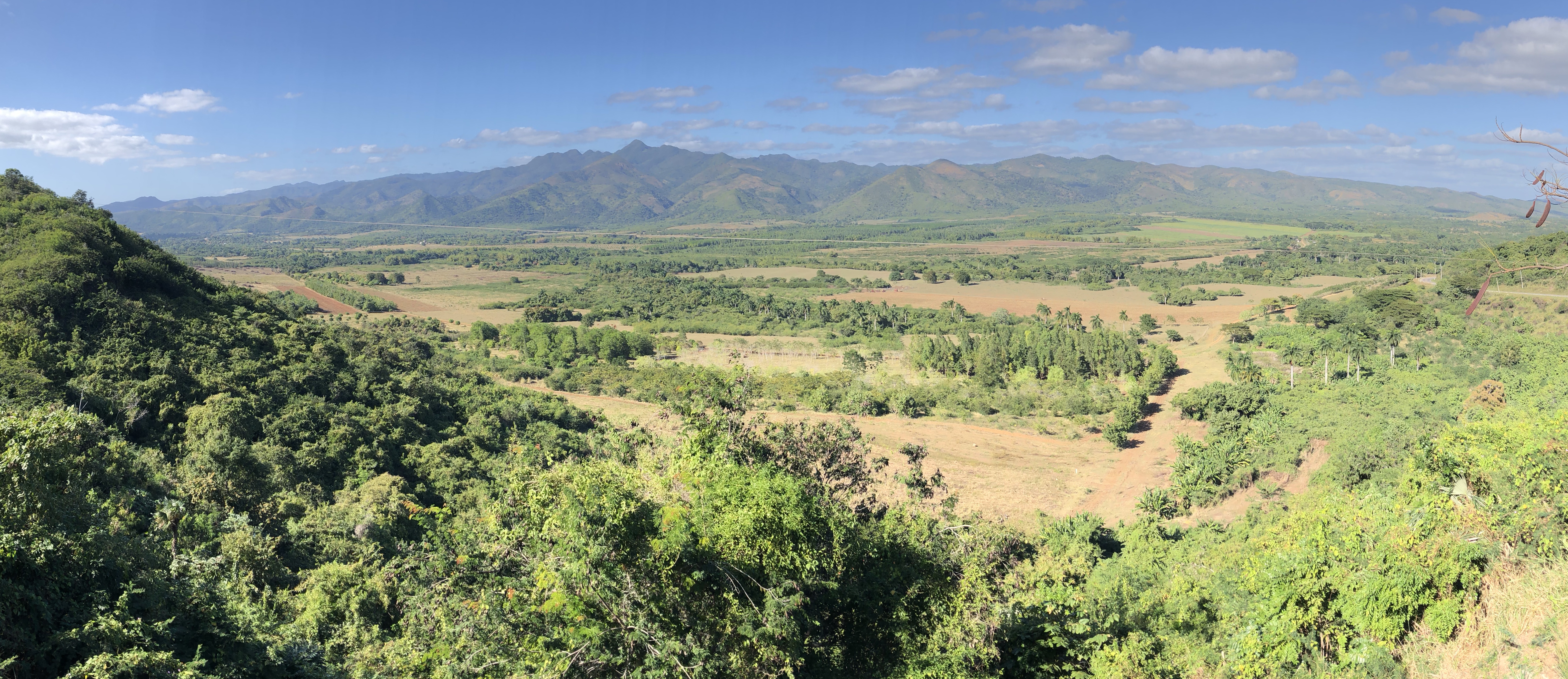
In the afternoon we split up as some people wanted to relax at the beach while others wanted to
visit la
Valle de Los Ingenios. I went with the second group. We rent a car to take us to the
panoramic point
from which we could see all the plain. This area, nowadays Unesco with the city of Trinidad, was
inhabited
by the creole aristocracy between XVII and XIX centuries as this was the perfect place where to
plant the
sugar cane. Today, some of the haciendas are still open to the public even if most of them
are in
ruins. We visited first San Isidro, where the house of the family and the tower are still
standing.
Around the house, there were no trees so that from the tower it was possible to observe the slaves
working
all the time. Later, we went to Manaca Iznaga, another old hacienda of which the main
attraction is
the high tower. From there, the view is breathtaking!
Once back, we realized we had to go Cienfuegos the day after, but the owner of our casa
did not
find any car, so I went with Barbara to the main square and we started asking. I had never done such
a thing
before, but it was quite fun. Of course, even when we found the cars, we had to contract to save
some money
but, in about 45 minutes, we managed to have our transportation means. Then, it was time for dinner,
the
real stress of the day. Finally, we arrived in front of one restaurant and decided to enter. It was
not
better nor worse than any other. The dinner was ok but the entertaining won. The owner of the place,
an old
man, invited me to dance while two guys were playing and singing (yes, also Chan Chan). Barbara even
bought
the album of the singer: Frank Batista Cubano soy. After dinner, we headed to la Casa de la Trova as
it
seemed everyone wanted to go there but, once there, everyone started with random excuses not to
enter.
Eventually, just me, Barbara, Mauro, and Valerio went inside. It was nice: live music, mojitos, just
a
normal day in Cuba.
Day 10
As planned the evening before, our two cars came to pick us up. The one I went on was indeed the
best of all
the travel: a Ford of 1935, canary yellow.
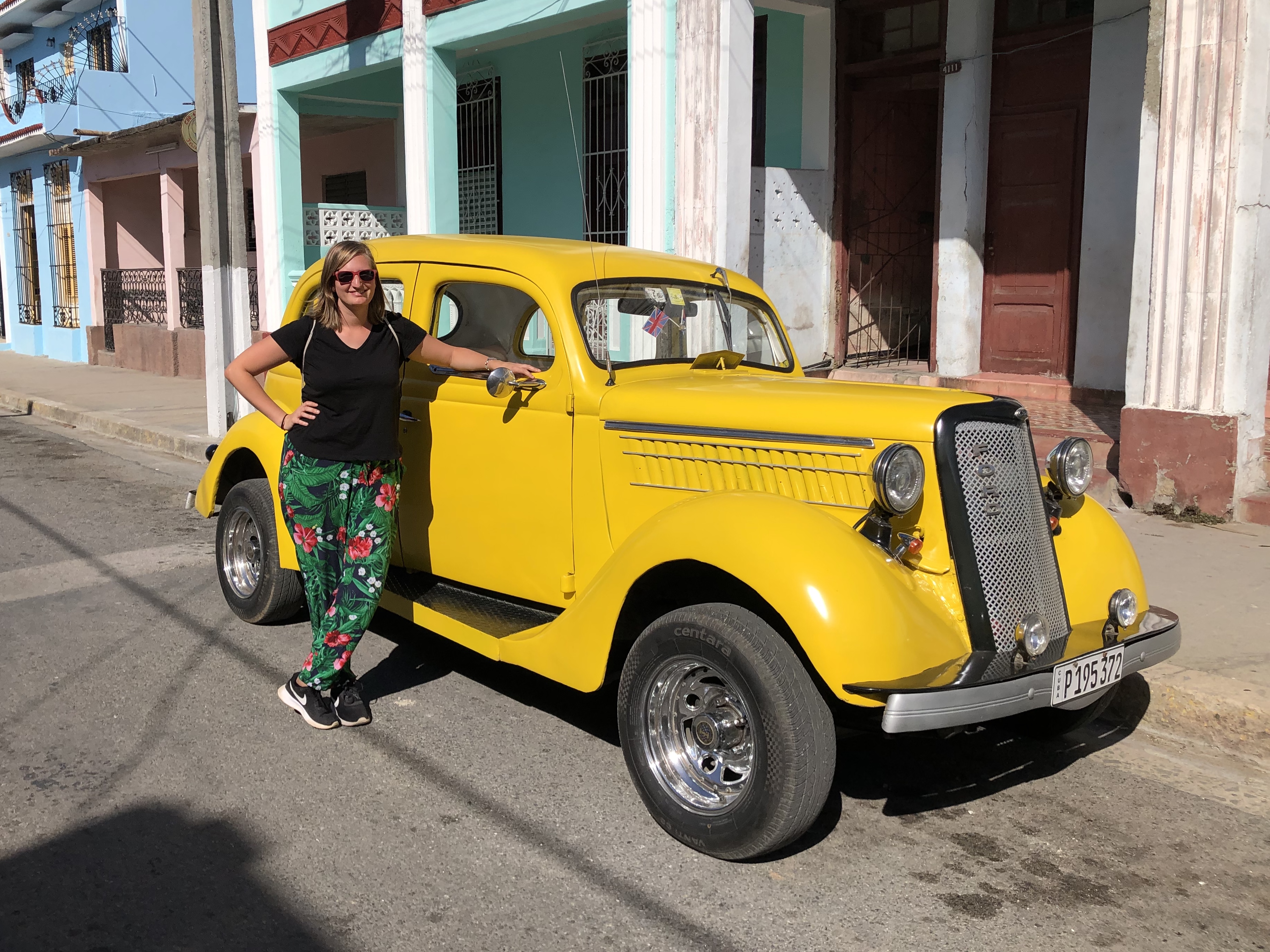 Like any other car, inside there was some small
modernization like a stereo and a Bluetooth connection. This meant I connected my phone and we
listened to
regueton music all the way to Cienfuegos. How can you even think of something as absurd and yet
genius as
this?
Like any other car, inside there was some small
modernization like a stereo and a Bluetooth connection. This meant I connected my phone and we
listened to
regueton music all the way to Cienfuegos. How can you even think of something as absurd and yet
genius as
this?
We went to our casas, two next to each other, left our stuff and went out to see the city. Even
though
Cienfuegos is a Unesco site, too, the city is disappointing. Except for the square, which is nice
but
nothing particular, the city does not really have anything interesting to see nor the atmosphere is
particularly enjoyable. We walked a lot but there was nothing so interesting to see. Probably, the
best
moment of the day was when we stopped to buy 'mortadella' at a local shop. I still wonder how that
was
made...
Finally, we split up and I stayed with Barbara. We found a local market and, inside,
there was
the shop of a photographer. We decided to enter to have our own portrait. It took a while, but we
got a
super kitsch photo with us, a romantic sunset in the background, a Cuban flag in one corner, and the
tagline
Cuba Particular to complete the masterpiece. I still need to find the appropriate frame to
exhibit it
at home. Then, we spend the rest of the afternoon calling one of our contacts in Cuba. The issue was
everyone was supposed to leave the day after to go to Vinales. There, it was possible to do the
excursion in
the tobacco fields or go to the beach. As the beach was not super close we ended up deciding to
split the
group into two parts: one would go to Vinales as planned and the other to a beach area. However, it
took
some time to have all the necessary confirmations in terms of casas and cars, so we were not sure
about it
until the very end. It was a bit stressful, especially because everyone else went to the swimming
pool to
relax while we stayed behind, but then everything was confirmed. We met the others to get a drink at
sunset
and then we went back to have dinner in our casa.
Day 11
The morning after I was already pissed because we would have not continued all together and I was
not really
in the mood of talking with anybody. We waited for our cars, which were late, and then left
Cienfuegos
without nostalgia.
 Our first stop was Museo Giron, close to the Bay of Pigs. Here, in 1961,
there was an attempt organized by the CIA to overcome the dictatorship of Fidel. Many Cubans who
escaped in
the previous years were prepared and given weapons to lead this attack that, on the outside, had to
appear
as something Cuban only. The attack ended up bad for the invaders, who were badly organized, and
Fidel won.
The museum is interesting because there are a lot of photos taken in those days and maps that
explain what
happens. On the other side, Cuba is still a dictatorship so everything Fidel and his men did is
shown as
good. As we should know, however, wars and conflicts never bring fairness and, even the parties with
the
best intentions may end up doing bad. Many Cubans were killed after the invasion because they were
enemies
and they did not get a trial. Anyway, it is still a museum that is worth a visit. After that, we
split up in
two: I went to Vinales with other five people while Barbara, Mauro, and the other two went north, to
Varadero.
Our first stop was Museo Giron, close to the Bay of Pigs. Here, in 1961,
there was an attempt organized by the CIA to overcome the dictatorship of Fidel. Many Cubans who
escaped in
the previous years were prepared and given weapons to lead this attack that, on the outside, had to
appear
as something Cuban only. The attack ended up bad for the invaders, who were badly organized, and
Fidel won.
The museum is interesting because there are a lot of photos taken in those days and maps that
explain what
happens. On the other side, Cuba is still a dictatorship so everything Fidel and his men did is
shown as
good. As we should know, however, wars and conflicts never bring fairness and, even the parties with
the
best intentions may end up doing bad. Many Cubans were killed after the invasion because they were
enemies
and they did not get a trial. Anyway, it is still a museum that is worth a visit. After that, we
split up in
two: I went to Vinales with other five people while Barbara, Mauro, and the other two went north, to
Varadero.
Our transfer was quite long, about five hours but we still managed to arrive there before sunset
and to
catch a glimpse of the valley. Vinales is not beautiful, it is just a city made up of two main
streets with
tourist restaurants and shops. However, the valley around is stunning and it was one of the best
things of
the travel. Our casa was ok but not one of the best. We talked to the owner of the casa to organize
the day
after in terms of excursions and cars and even if with some challenges, we set everything. Done
that, we
went out to have dinner.
Day 12
This was probably the best day of all the ones spent in Cuba. We woke up a bit early to do the
horse-riding excursion. It is the most common one as Vinales is famous for the tobacco
fields
and the only ways to explore it is walking or riding.
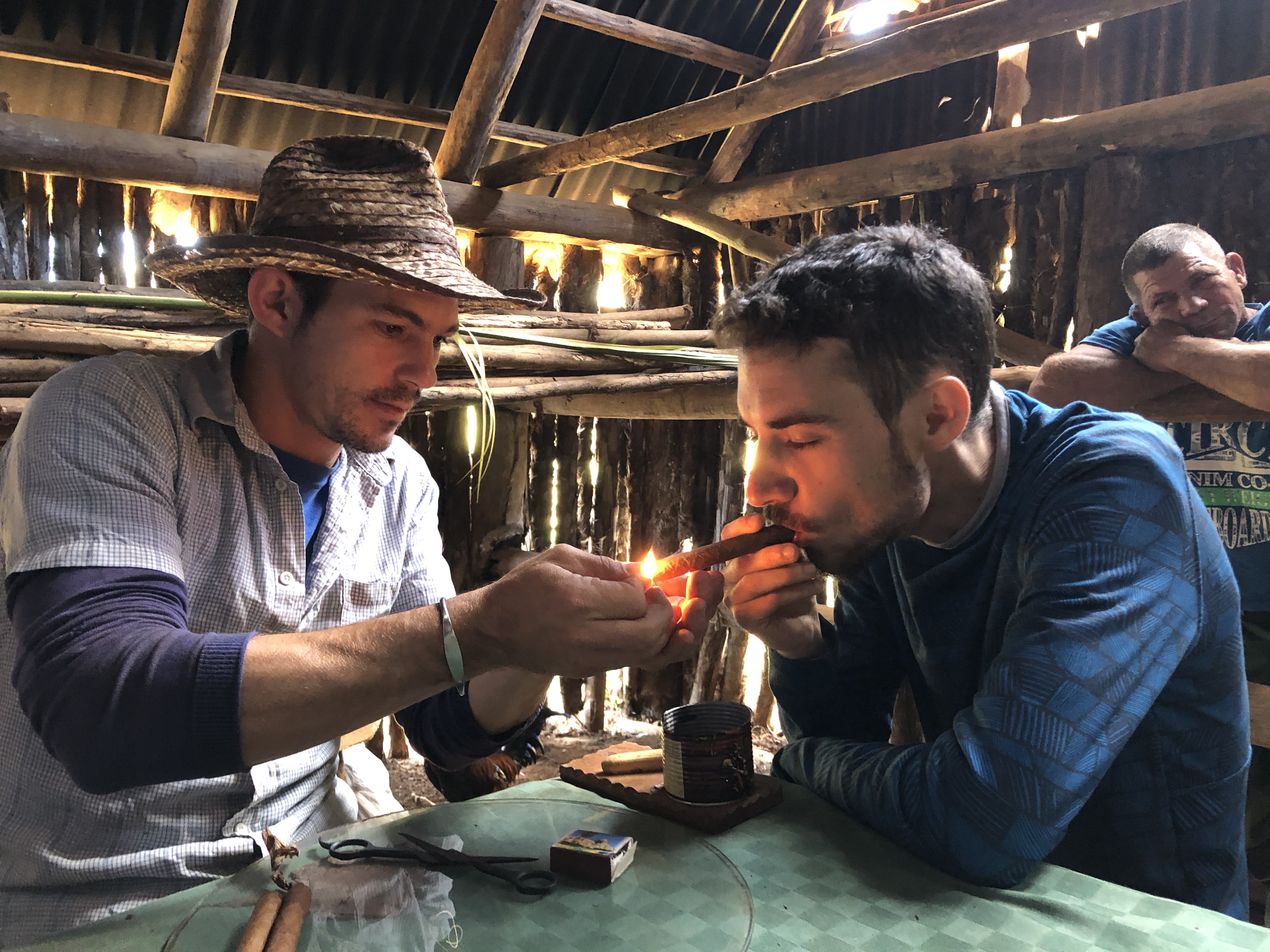 I had never been on a horse before, except for a pony
when I was 9 years old so, even if I was super excited about it, I got a bit scared. However, my
horse was
super calm and peaceful. His name was Caramelo and he had to be second in line. No matter what, if
someone
was trying to pass him, he had to stop him and keep being the second. When the position was secured,
he
could walk slowly as before. The riding was beautiful, two hours immersed in green fields with no
artificial
noises, no machines but just us, other people, and animals. We stopped twice, the first time to meet
a
family of farmers who explained to us everything about tobacco. For instance, that the seeds are
spread in
the fields and then, the best plants are taken and replanted in lines. The State knows exactly how
many
plants there are and takes 90% of the production at the end of the season. The remaining 10% is left
to the
farmers for their own consumption or private selling. The tobacco plants have three levels of
leaves, the
higher ones being the best in quality. The farmers only keep the highest ones and the middle ones
while the
State take a bit of all the three levels. The highest ones are the best and used to produce
top-quality
cigars. All the leaves are collected and sent to the State Factories, where they follow a
chemical
process to ferment and then are pressed in order to produce cigars. The different names they get it
is just
a matter of size as the same leaves are used for all the cigars of the same quality. The homemade
process is
a bit different and the guy explained it to us. They produce a sort of infusion with different
fruits and
spices that then they put on the leaves. They are then packed into palm leaves and left there to
ferment for
about 6 months. After that time, the leaves are ready to be transformed into cigars. He showed us
how to do
a cigar in 5 minutes. Probably you need to grow up there to be able to do such a thing! The best
thing is no
artificial product is used to create one and the leaves just stick to one another.
I had never been on a horse before, except for a pony
when I was 9 years old so, even if I was super excited about it, I got a bit scared. However, my
horse was
super calm and peaceful. His name was Caramelo and he had to be second in line. No matter what, if
someone
was trying to pass him, he had to stop him and keep being the second. When the position was secured,
he
could walk slowly as before. The riding was beautiful, two hours immersed in green fields with no
artificial
noises, no machines but just us, other people, and animals. We stopped twice, the first time to meet
a
family of farmers who explained to us everything about tobacco. For instance, that the seeds are
spread in
the fields and then, the best plants are taken and replanted in lines. The State knows exactly how
many
plants there are and takes 90% of the production at the end of the season. The remaining 10% is left
to the
farmers for their own consumption or private selling. The tobacco plants have three levels of
leaves, the
higher ones being the best in quality. The farmers only keep the highest ones and the middle ones
while the
State take a bit of all the three levels. The highest ones are the best and used to produce
top-quality
cigars. All the leaves are collected and sent to the State Factories, where they follow a
chemical
process to ferment and then are pressed in order to produce cigars. The different names they get it
is just
a matter of size as the same leaves are used for all the cigars of the same quality. The homemade
process is
a bit different and the guy explained it to us. They produce a sort of infusion with different
fruits and
spices that then they put on the leaves. They are then packed into palm leaves and left there to
ferment for
about 6 months. After that time, the leaves are ready to be transformed into cigars. He showed us
how to do
a cigar in 5 minutes. Probably you need to grow up there to be able to do such a thing! The best
thing is no
artificial product is used to create one and the leaves just stick to one another.
After this demonstration, we took again our horses and kept going. The second stop was for a
coffee
plantation. They showed us the plants, the process of toasting, and then the coffee seeds
ready to be
used. Then they showed us some honey and some Rum. We had a try of everything and then headed back
to
Vinales city. We refreshed a bit and then the car we booked the day before arrived. Late, obviously.
We had
a bit of a discussion because they wanted to charge us more and so on but then we left. We wanted to
go and
see Cueva de San Miguel, a huge cave. It was indeed interesting, but I did not dare to go too
far
because it was not easy to go down and then back up, so I preferred to stay behind. After that, we
did a
short stop at the Mural de la Prehistoria, a huge painting made on a mountain in 1961. Then
we drove
on the opposite side of the town to reach another panoramic point (well, not so panoramic to be
honest) and
have a drink. We then came back tired but satisfied with the day.
Day 13
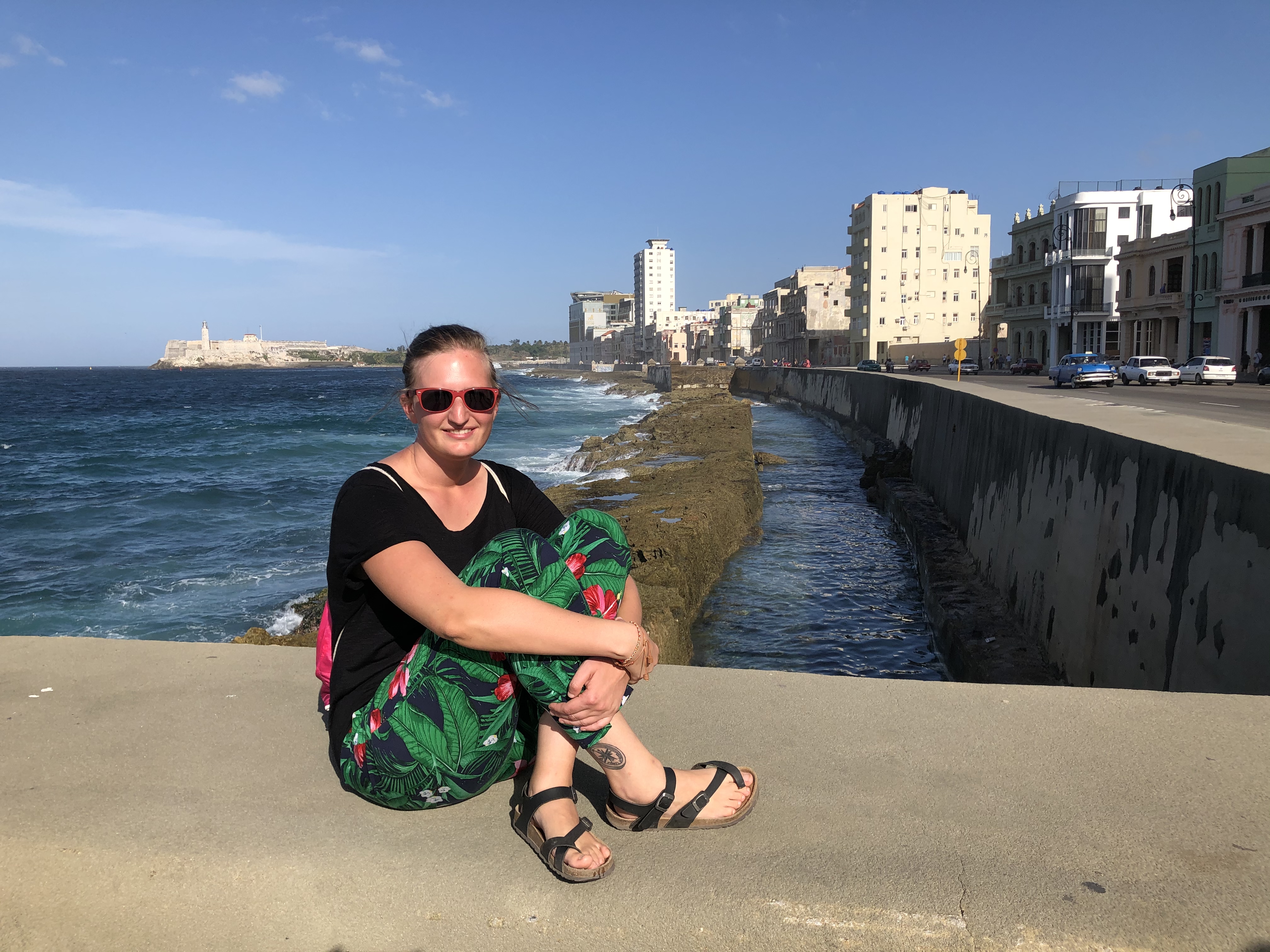 This was basically a transfer day. We left around 10 to go to Habana and we arrived around 12.30. we
met the
others and then we split into small groups. I wandered with some in Old Habana with no destination.
It was
nice just being on the Malecon with the only worry of getting a Crystal somewhere. At one point,
since it
was 4 PM and we had nothing to eat except for breakfast, we entered a fast food shop. Forget about
Mc
Donald’s, that’s something that we still won’t see there for many years (I hope!). Still, they have
some
shops where they make hamburgers and, being it for hunger or just out of curiosity we ordered food.
Of
course, we ordered the only hamburger left among the various choices on the menu. Have no
expectations when
asking for food, what you want will never be available. The meal was actually pretty good, and we
felt
better thinking with our bellies full. We reunited with the others after we managed to call them and
kept
wandering around until about 6 PM when we headed back to shower before dinner. For that, we went all
together to a nice restaurant downstairs our casa. After dinner, we found a place nearby where you
could
shoot with pneumatic guns. That was so totally random! Then we split again but we could not find any
place
where to sit and have a drink. It seems you really need to go to tourist places to find some
nightlife in
Cuba and, even there, only until midnight.
This was basically a transfer day. We left around 10 to go to Habana and we arrived around 12.30. we
met the
others and then we split into small groups. I wandered with some in Old Habana with no destination.
It was
nice just being on the Malecon with the only worry of getting a Crystal somewhere. At one point,
since it
was 4 PM and we had nothing to eat except for breakfast, we entered a fast food shop. Forget about
Mc
Donald’s, that’s something that we still won’t see there for many years (I hope!). Still, they have
some
shops where they make hamburgers and, being it for hunger or just out of curiosity we ordered food.
Of
course, we ordered the only hamburger left among the various choices on the menu. Have no
expectations when
asking for food, what you want will never be available. The meal was actually pretty good, and we
felt
better thinking with our bellies full. We reunited with the others after we managed to call them and
kept
wandering around until about 6 PM when we headed back to shower before dinner. For that, we went all
together to a nice restaurant downstairs our casa. After dinner, we found a place nearby where you
could
shoot with pneumatic guns. That was so totally random! Then we split again but we could not find any
place
where to sit and have a drink. It seems you really need to go to tourist places to find some
nightlife in
Cuba and, even there, only until midnight.
Day 14
And then we arrived on the last day of our adventure in Cuba. Thankfully, the flight was in the
night, so we
had time to still do some things in the city. I went with Barbara, Americo, and Valerio to the
house of
Hemingway, a bit out of the city center. Only getting there was an adventure as we took a
city bus. In
the beginning, it was not clear why there was more than one line at the bus stop, then we understood
that
entering with priority was more expensive but gave more chance to sit. Arriving there was quite long
as
there was a lot of traffic and the bus was stopping everywhere. At one point, some guys put some
music on.
No one was complaining or was upset as people are in Europe or Western countries in general. They
were
patiently waiting for their stop and that was all. Once arrived, we made our tickets and entered the
park.
The house is not big, and you cannot enter but all the windows and doors are open, so it seems
you are
spying into someone’s private life. We were thinking this would have made the visit less
interesting, but it
was a perfect idea as everything is exactly how it was left (well, probably not but it looks like).
All the
windows give the house a sense of light and relax and the wind flowing around made it comfortable
even if it
was very hot.
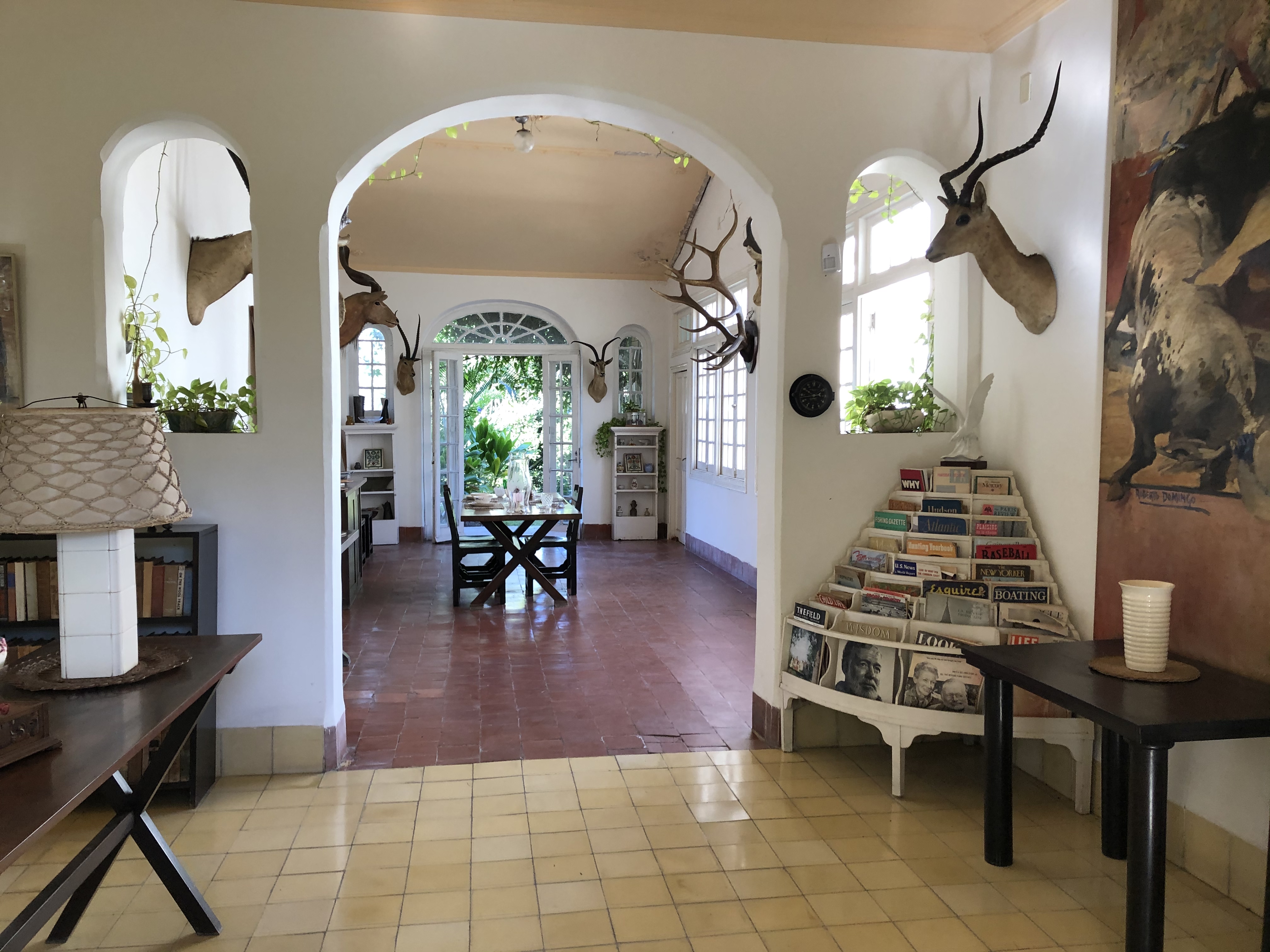 And there are books everywhere, even in the bathroom they are organized with proper libraries.
And there are books everywhere, even in the bathroom they are organized with proper libraries.
Hemingway was in love with Cuba, even when the relations between Cuba and the US started to
deteriorate.
Besides writing from his house, he was often out fishing on his boat, Pilar, now parked in the
garden, next
to the swimming pool where, it seems, famous divas swam naked. He was also enjoying the parties in
Habana
and his favorite bars were La Bodeguita del Medio and La Floridita, now open to masses of tourists.
After our visit, we had to find a way to go back. The bus schedule was not clear (not sure there was
one at
all) and so we opted for a taxi. We tried to stop some and then we jumped on what there is called a
collective taxi. It works almost like a bus, but it is a taxi. You jump on and then you get
off at
your destination. We asked if it was going where we needed to go so we were sure, but the rest of
the people
was just boarding without even checking if the destination was correct. One of the many mysteries of
Cuba.
The good part was the price was very low, even with the foreigner extra. Once back, we went to the
Museo
de la Revolucion, but it was huge and the ticket very expensive, so we decided not to enter.
From the
outside, it is visible anyway its main attraction: the Granma. This is a small boat, 19.2 m
long,
that Fidel and 81 of his men took to go from Mexico to Cuba in 1956. The idea was to reach the
island and
start the revolution but, after 7 days in the sea in such a small boat, everyone arrived sick and
exhausted
and the original plan was not respected. In any case, Granma is a symbol of fight and freedom and
even a
newspaper is called that way. Then, Valerio left to go around alone, and I went to eat with Barbara
and
Americo as the meeting with Leonardo and Mauro was later. We found another hamburger place and
ordered
there. Again, the food options were limited but still, we were satisfied. In the afternoon we walked
around
again and then I went with Barbara and Mauro to take the last cocktail in Habana.
Before leaving
the
city, we could take a shower in the casa and then, around 6, a taxi came to pick us up and go to the
airport. We bought a couple of Tukola and something to eat before boarding the plane (Barbara almost
missed
it!). The flight back was ok, Barbara gave me some pills to sleep and I did not suffer much, I
suffered more
because I was leaving behind an amazing journey and a wonderful country. I do really hope to go back
one
day, wishing Cubans to improve their lives and freedom but hoping they manage to stay true to
themselves and
keep the spirit of this country alive.